Introduction & Overview of the PlayStation Brand
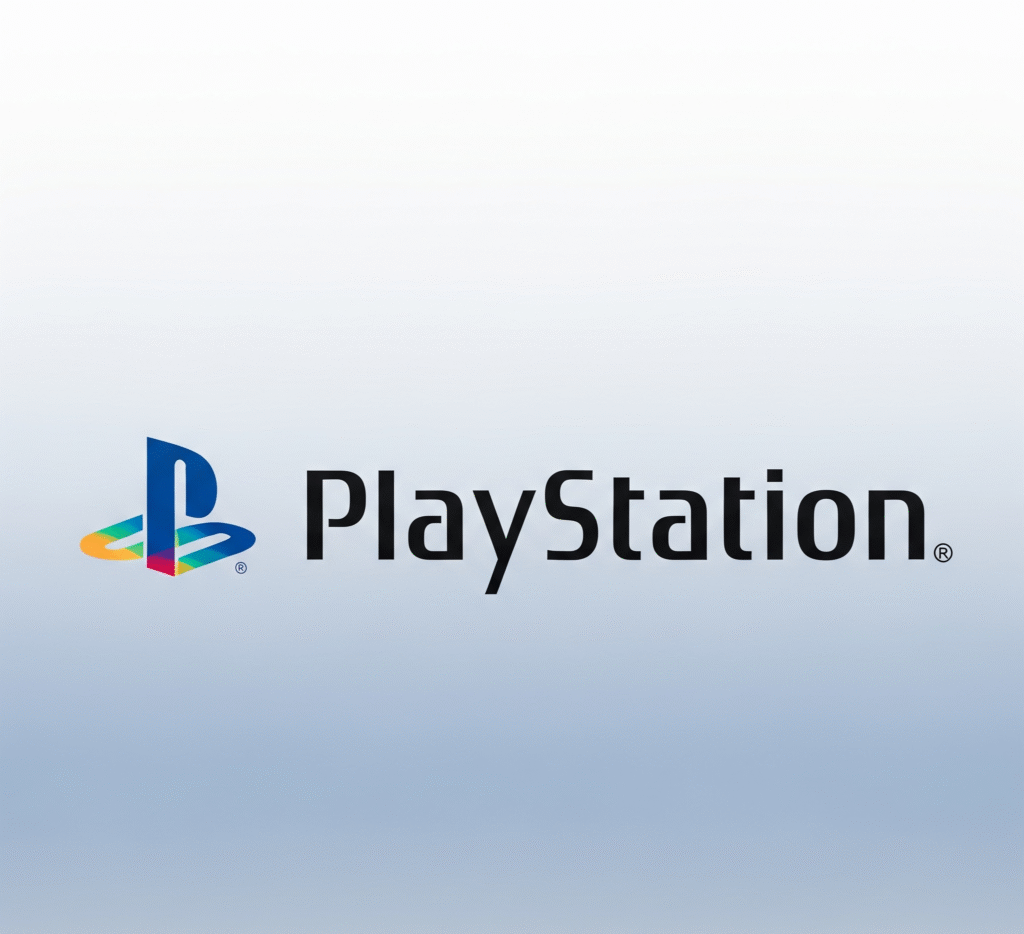
The PlayStation brand, a globally recognized name in interactive entertainment, is owned by Sony Interactive Entertainment (SIE), a wholly owned subsidiary of Sony Group Corporation. The brand encompasses a series of home video game consoles, handheld gaming devices, a microconsole, an extensive media brand, comprehensive online services, a line of distinctive controllers, and, more recently, PlayStation Productions, a company dedicated to adapting its popular game intellectual properties (IPs) into films and television series. The journey of PlayStation began with the launch of its inaugural home console in Japan on December 3, 1994, an event that marked a pivotal moment in the video game industry. Since its inception, PlayStation has consistently been at the forefront of entertainment and innovation, delivering compelling and immersive experiences to a worldwide audience through its advanced hardware, pioneering network services, and a library of critically acclaimed and commercially successful games.
The enduring success and longevity of the PlayStation brand can be attributed not merely to its technological advancements in hardware but, more significantly, to the meticulous cultivation of a comprehensive and interconnected ecosystem. This ecosystem integrates hardware, a vast software library, robust online services, and, increasingly, transmedia entertainment ventures. The initial triumph of the first PlayStation (PS1) laid a formidable hardware foundation. Subsequent generations strategically built upon this by incorporating new media formats, such as the DVD on the PlayStation 2 (PS2) and Blu-ray on the PlayStation 3 (PS3) , thereby expanding their utility beyond gaming into broader home entertainment. The brand further solidified its market position by venturing into online services with the PlayStation Network (PSN) and the PlayStation Store , and by developing subscription models like PlayStation Plus. The recent establishment of PlayStation Productions signals a strategic expansion, aiming to leverage its rich portfolio of IPs across diverse entertainment mediums, thereby enhancing brand presence and deepening audience engagement. This multifaceted strategy underscores a long-term vision focused on ecosystem development rather than solely on console sales.
Sony’s Transformative Entry into the Console Market
Sony’s foray into the video game console market in the mid-1990s was a transformative event for an industry then largely dominated by established players like Nintendo and Sega. The launch of the first PlayStation console introduced groundbreaking 3D graphics capabilities and championed the use of optical disc technology, specifically CD-ROMs, for game distribution—a significant departure from the cartridge-based systems prevalent at the time. This move was particularly noteworthy for Sony, a corporation renowned for its high-level consumer electronics, which had initially viewed video games with some skepticism, perceiving them more as toys than as a serious avenue for their technological expertise.
The resounding success of the original PlayStation quickly dispelled any internal doubts and signaled Sony’s ascent as a formidable power in the video game world. The console achieved a historic milestone by becoming the first of any type to ship over 100 million units worldwide, cementing the PlayStation brand as a global icon. Sony’s entry was characterized not just by the introduction of a new piece of hardware, but by a fundamental shift in the technological and business paradigms of the gaming industry. The adoption of CD-ROMs was a key element of this shift. While Nintendo’s dominance had been partly sustained by the cartridge format, which afforded them considerable control over manufacturing and licensing, Sony’s choice of CD-ROMs for the PS1 offered distinct advantages: significantly larger storage capacity and substantially lower manufacturing costs. This technological choice, combined with more developer-friendly policies compared to Nintendo’s perceived favoritism towards its own titles , attracted a broad spectrum of third-party developers. This strategic pivot effectively democratized game development to a degree, fostering a more diverse and extensive game library. The expansive software catalog became a critical factor in the PS1’s success and its capacity to effectively challenge and ultimately surpass established industry leaders. Furthermore, the reduced cost of CD production translated into potentially lower retail prices for games, broadening the market appeal of the PlayStation platform.
The Genesis of PlayStation
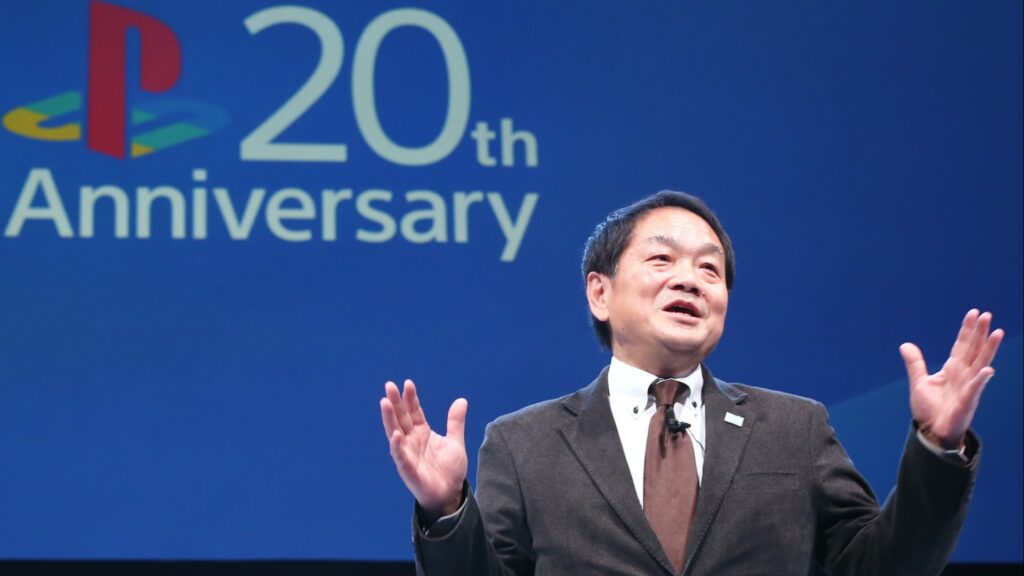
The Vision of Ken Kutaragi: “The Father of PlayStation”
The creation and subsequent global success of the PlayStation brand are inextricably linked to the vision and tenacity of Ken Kutaragi, a Sony engineer widely acclaimed as “The Father of the PlayStation.” Kutaragi’s deep-seated interest in the potential of video games was reportedly ignited in 1983 after observing his young son playing Nintendo’s Famicom system. This experience led him to recognize the untapped possibilities within interactive entertainment. His engineering acumen was first directed towards the gaming industry when he, working in secrecy from many of his Sony superiors, designed the SPC700 sound chip for Nintendo’s Super Nintendo Entertainment System (SNES). Kutaragi harbored a grander vision: to elevate the console gaming experience through superior industrial design, enhanced sound quality, and, most critically, the then-nascent technology of 3D graphics, all powered by Sony’s formidable technological research and development capabilities.
Kutaragi’s unwavering belief in the potential of a Sony-developed console and his persistence were crucial in navigating the internal skepticism within Sony, a company that, at the time, did not view the video game market as a primary area of focus. His ability to champion this vision internally demonstrates the significant impact an individual with strong conviction and technical expertise can have in steering a large corporation towards new and innovative ventures, even in sectors previously considered outside its core business.
Sony’s Initial Hesitation and the Pivotal Nintendo Partnership
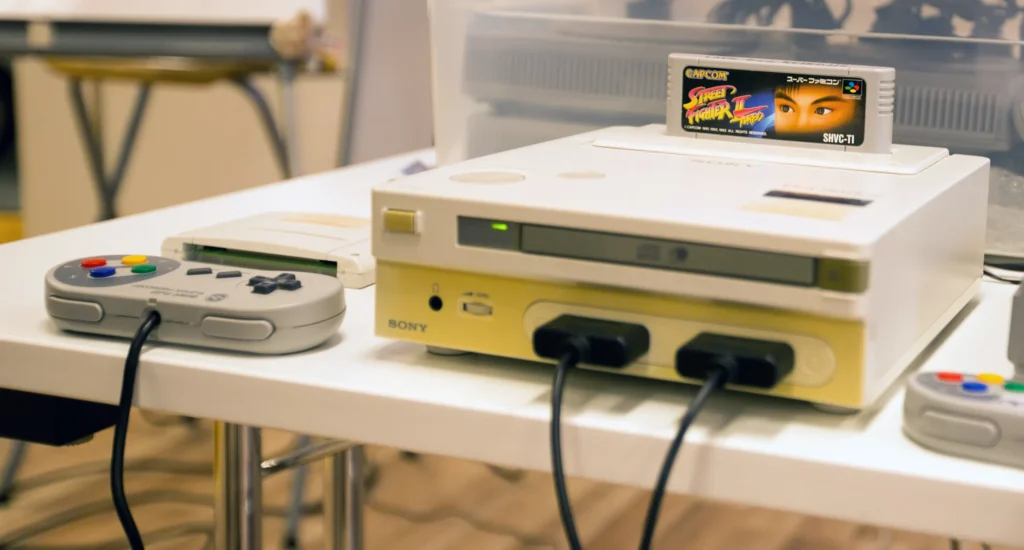
In the late 1980s and early 1990s, Sony Corporation was primarily known for its consumer electronics like the Walkman and Trinitron televisions, and was initially hesitant to venture into the burgeoning video game market, which some within the company perceived as a domain of toys rather than sophisticated electronics. However, Ken Kutaragi successfully persuaded Sony’s then-CEO, Norio Ohga, to explore a collaborative effort with Nintendo, the dominant force in the video game industry at the time. This partnership aimed to develop a CD-ROM add-on for the Super Nintendo Entertainment System (SNES). The scope of this collaboration extended beyond a mere peripheral; it also included plans for a Sony-branded console that would be compatible with both existing SNES cartridges and the new CD-ROM-based “Super Disc” games.
This initial, albeit ultimately unsuccessful, partnership with Nintendo served as an indispensable catalyst for Sony. It provided the company with its first tangible experience in the console gaming sphere and, more importantly, created the strategic impetus and foundational knowledge that would lead Sony to pursue an independent path into the console market. The joint project, which was to be named the “Play Station” (with a space between “Play” and “Station”) , allowed Sony to delve into the potential of CD-ROM technology for gaming applications alongside an established industry leader. The subsequent and very public dissolution of this partnership, particularly Nintendo’s surprising announcement of an alliance with Philips at the Consumer Electronics Show (CES) in 1991 , is believed to have profoundly fueled Sony’s determination. This turn of events transformed Sony from a potential partner into a motivated competitor, eager to leverage its own technological strengths to enter and redefine the console market.
The “Play Station” Prototype and the Dissolution of the Nintendo Deal
The collaborative venture between Sony and Nintendo resulted in the development of a prototype device known as the “Play Station.” This console was designed with dual compatibility, capable of playing standard Super NES cartridges as well as the newly conceptualized “Super Disc” CD-ROMs. Reports suggest that approximately 200 of these prototype units were manufactured, making them exceedingly rare artifacts of video game history. One such prototype, owned by Ken Kutaragi himself, remains in pristine condition.
The promising partnership, however, ultimately unraveled due to fundamental disagreements over licensing terms and control of the CD-ROM format. Nintendo grew wary of the level of control Sony sought over the CD-ROM technology and its associated software licensing, fearing it would cede too much power to Sony in the burgeoning optical disc market. Consequently, Nintendo made a strategic pivot, secretly entering into a new partnership with Philips to develop a CD add-on for the SNES. Nintendo’s public announcement of this alliance with Philips at the 1991 Consumer Electronics Show served as the de facto termination of the Sony-Nintendo collaboration.
The collapse of the Nintendo partnership was a watershed moment, directly precipitating Sony’s decision to create its own independent PlayStation brand. The core of the dispute lay in Nintendo’s apprehension about relinquishing control over software licensing and hardware standards, particularly concerning the CD-ROM format, which Sony was championing. Sony’s vision for the “Play Station” likely entailed a more prominent and controlling role for itself than Nintendo was willing to concede. This fundamental clash of strategic interests, culminating in a very public and somewhat acrimonious separation, left Sony with the developed CD-ROM technology and a powerful motivation to enter the market not as a subordinate partner but as a direct and formidable competitor. The few existing “Nintendo PlayStation” prototypes stand as tangible evidence of this pivotal, yet ultimately failed, alliance that inadvertently set the stage for a new titan in the video game industry.
Forging an Independent Path: Conceptualizing the First PlayStation
Following the dramatic dissolution of the partnership with Nintendo, Ken Kutaragi, with the crucial and continued backing of Sony CEO Norio Ohga, spearheaded the ambitious project to develop Sony’s own standalone video game console. This endeavor marked Sony’s independent entry into the fiercely competitive console market. Kutaragi’s vision was clear and bold: to leverage Sony’s cutting-edge technological expertise to create the most powerful home console available at the time. This was a direct philosophical counterpoint to what he perceived as Nintendo’s more conservative approach of utilizing “primitive, outdated technology” for its gaming hardware.
A cornerstone of Sony’s strategy for its new console, internally codenamed “PS-X” during its development phase , was the decision to target an older demographic of gamers. Kutaragi identified that the existing market, largely dominated by Nintendo, was primarily focused on children. He astutely recognized an untapped market segment: adult gamers who were seeking more mature and sophisticated interactive entertainment experiences. This demographic targeting would profoundly influence the PlayStation’s marketing and the types of games developed for the platform.
Technologically, the first PlayStation was engineered with a strong emphasis on 3D polygon graphics. This focus was significantly influenced by the burgeoning success of 3D arcade games, such as Sega’s groundbreaking Virtua Fighter, which demonstrated the immersive potential of three-dimensional visuals. The commitment to robust 3D capabilities became a primary design principle for the console. This strategic direction, combining technological superiority with a differentiated target audience and a forward-looking embrace of 3D gaming, collectively defined the PlayStation’s unique market position and set it apart from the established leaders of the era, paving the way for its eventual industry dominance.
Home Console Generations: A Legacy of Innovation
PlayStation (PS1): The Dawn of 3D Gaming (1994-2006)
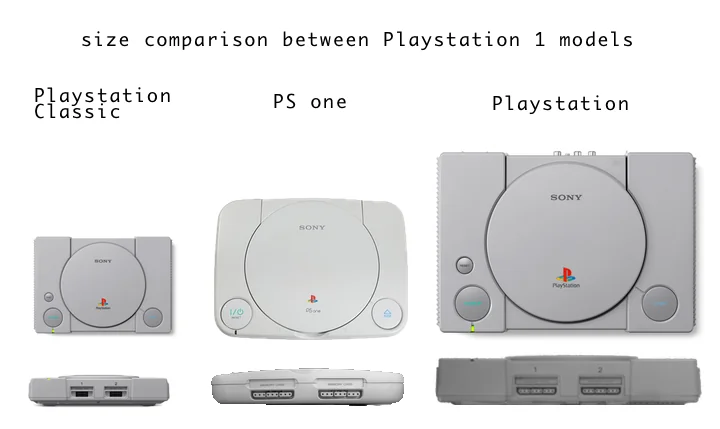
Launch, Market Context, and Competitive Landscape:
The original PlayStation, often referred to as PS1, made its debut in Japan on December 3, 1994, with an introductory price of ¥39,800. Its North American launch followed on September 9, 1995, priced at US$299, and the European release occurred on September 29, 1995, at £299. The console entered the fifth generation of video game consoles, a period marked by a significant technological shift towards 3D graphics and optical media. Its primary competitors were the Nintendo 64 and the Sega Saturn.
Sony’s entry into the market was characterized by an aggressive pricing strategy. Notably, at the 1995 Electronic Entertainment Expo (E3), Sony announced the PS1’s $299 price point for the US market, strategically undercutting the Sega Saturn (which had a surprise launch at E3 for $399) by a significant $100. This pricing, coupled with a marketing campaign that targeted a more mature, youth-oriented audience with slogans like “U R Not E” (You Are Not Ready) and later “LIVE IN YOUR WORLD. PLAY IN OURS.” , proved instrumental in its initial success. The PlayStation’s launch was a remarkable triumph; it sold 100,000 units on its first day in Japan and reached two million units sold within six months. In North America and Europe, it quickly outsold the Sega Saturn in the early months following its release.
The PS1’s success was not merely a consequence of its hardware capabilities; it was also the result of astute market positioning and a keen understanding of the evolving gaming demographic. While established players like Nintendo and Sega had their respective strengths, they also presented vulnerabilities that Sony exploited. Nintendo’s N64, though powerful, controversially retained the cartridge format for its games. Cartridges were more expensive to produce than CDs, offered less storage capacity, and this decision alienated some third-party developers. The Sega Saturn, on the other hand, possessed a complex dual-CPU architecture that made game development challenging and launched at a higher price point. Sony capitalized on these factors by offering a technologically advanced, CD-based 3D console at a highly competitive price, supported by marketing that portrayed the PlayStation brand as edgy, sophisticated, and appealing to an older teen and young adult audience. This comprehensive strategy enabled PlayStation to rapidly capture significant market share and redefine consumer expectations for home console gaming.
Technical Specifications & Hardware Innovations:
The PlayStation (PS1) featured a 32-bit LSI CoreWare CW33300-based MIPS R3000A-compatible RISC CPU, specifically an R3051 variant, operating at a clock speed of 33.8688 MHz and delivering approximately 30 MIPS (Million Instructions Per Second). Its graphics were handled by a dedicated Sony GPU, designed by Toshiba, which was capable of rendering up to 360,000 flat-shaded polygons per second, or 180,000 polygons per second with textures and Gouraud shading applied. The system was equipped with 2 MB of main EDO DRAM and 1 MB of VRAM for graphics. For audio, the PS1 utilized a custom 16-bit Sony SPU (Sound Processing Unit) supporting 24 ADPCM (Adaptive Differential Pulse Code Modulation) channels and a sampling rate of up to 44.1 kHz, allowing for rich and complex soundscapes. Games and other media were delivered via a CD-ROM drive operating at double speed (2x), with a maximum storage capacity of approximately 660 MB per disc.
Several key hardware innovations distinguished the PlayStation:
CD-ROM Format: This was arguably the most transformative innovation. The shift from cartridges to CD-ROMs provided vast storage capacity, enabling developers to incorporate extensive full-motion video (FMV) sequences, higher-quality audio tracks (including Red Book audio), and significantly larger and more detailed game worlds. Furthermore, CD-ROMs were considerably cheaper and faster to manufacture in bulk compared to ROM cartridges. This reduced financial risk for publishers, encouraged a wider variety of game releases, and allowed Sony to offer games at potentially lower retail prices to consumers while maintaining profitability.
3D Polygon Graphics: The console was engineered with a primary focus on real-time 3D graphics rendering, representing a significant leap from the predominantly 2D experiences of previous console generations. A specialized co-processor integrated within the main CPU, known as the Geometry Transfer Engine (GTE), was dedicated to handling the complex mathematical calculations required for 3D graphics.
MDEC (Motion Decoder): The PlayStation included a proprietary video compression unit, MDEC, integrated directly into the CPU. This hardware component enabled higher quality full-motion video playback than contemporary consoles that relied on software-based decoding or less efficient custom hardware.
Relatively Developer-Friendly Environment: While early 3D development was challenging across all platforms, Sony made efforts to create a more accessible development ecosystem compared to some of its competitors. The initial expensive MIPS R4000-based Sony NEWS workstations were later supplemented by more affordable PC-based development systems created through a collaboration between Sony-owned Psygnosis and SN Systems. This shift towards cheaper and more efficient software design tools was a significant factor in attracting a large number of third-party developers to the platform.
The PS1’s hardware innovations were not merely incremental technical improvements; they were strategic decisions that fundamentally reshaped the possibilities for game design and altered the economic landscape of the video game industry. The large storage capacity of CDs, for instance, directly enabled developers to create more cinematic and narrative-driven experiences, as exemplified by titles like Final Fantasy VII with its extensive FMV sequences and pre-rendered backgrounds. This, in turn, influenced player expectations and the evolution of game genres. The lower cost of CD production also fostered a more diverse software library by reducing the barrier to entry for publishers. The dedicated focus on 3D graphics pushed the boundaries of visual fidelity and gameplay mechanics, defining the aesthetic and interactive paradigms of the fifth console generation.
Controllers
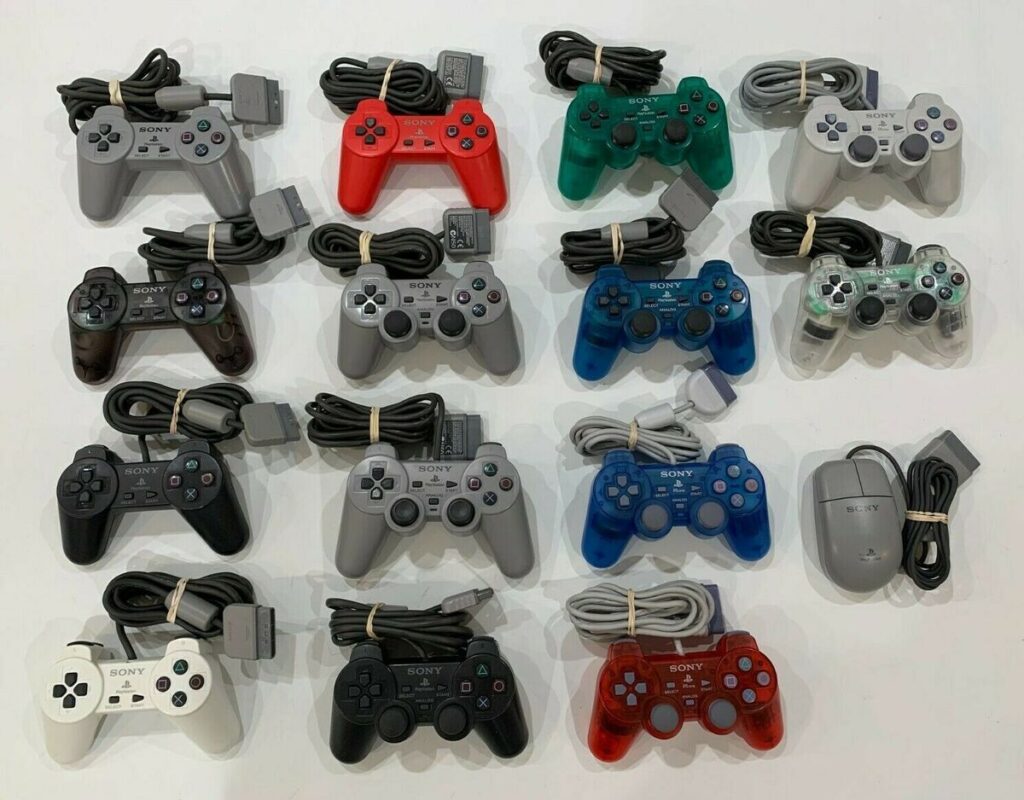
PlayStation Controller (December 1994): The original controller, launched with the console, established the ergonomic design and introduced the iconic PlayStation face buttons: a green triangle, a red circle, a blue cross (X), and a pink square. These symbols would become synonymous with the PlayStation brand.
Dual Analog Controller (April 1997): Recognizing the need for more precise control in the increasingly prevalent 3D gaming environments, Sony introduced the Dual Analog Controller. This iteration added two analog sticks, offering players a greater degree of movement and camera control.
DualShock Controller (November 1997): Building upon the Dual Analog design, the DualShock controller incorporated vibration feedback (rumble) technology, providing tactile sensations that corresponded with in-game events, thereby enhancing player immersion. The DualShock quickly became the standard controller for the PlayStation and its successors. The SCPH-7001 model of the PS1 standardized the inclusion of the DualShock controller.
Memory Card: Due to the read-only nature of CD-ROMs, external memory cards were essential for saving game progress. Standard PlayStation memory cards offered 128 KB of flash memory, organized into 15 blocks, providing 8MB of total storage.
Multitap: To facilitate local multiplayer gaming beyond two players, the Multitap accessory was available. A single Multitap allowed up to four controllers to be connected to one controller port. By using two Multitaps, up to eight players could join a game, supporting titles designed for larger group play.
Other notable accessories included the PlayStation Mouse, primarily used for strategy games and light gun titles, and the PocketStation, a Japan-exclusive memory card peripheral with its own monochrome LCD screen and mini-game capabilities. An attachable 5” LCD screen for the PS one model, allowing for portable play without a television, was also released.
The evolution of the PlayStation controller, culminating in the DualShock, was particularly significant. It established a design paradigm—featuring a D-pad, face buttons, shoulder buttons, analog sticks, and vibration feedback—that profoundly influenced console controller design for subsequent generations across the industry. This iterative refinement, driven by the demands of new 3D gaming experiences and a desire for increased player immersion, solidified a controller layout that many competitors would later adopt or adapt, underscoring PlayStation’s impact on the ergonomics and interactive feedback mechanisms of console gaming.
Software Ecosystem: Iconic Games and Third-Party Developer Relations:
The PlayStation boasted an exceptionally vast and diverse software library, which was a cornerstone of its global success. Over 4,000 game titles were released for the platform worldwide, with cumulative software sales reaching an impressive 962 million units. This extensive catalog was a testament to Sony’s successful strategy of fostering strong relationships with third-party developers.
Several iconic and critically acclaimed franchises either debuted or rose to prominence on the PlayStation. These defining titles included:
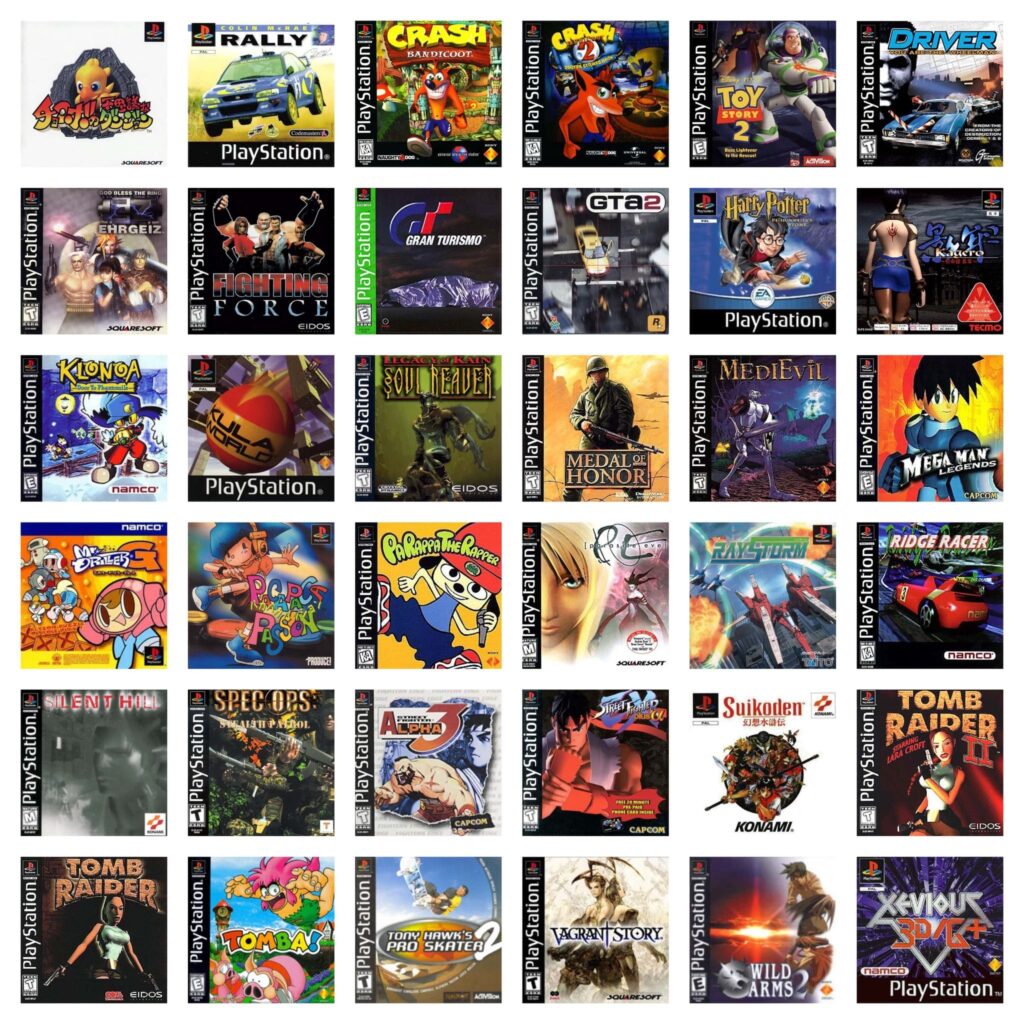
Gran Turismo: Developed by Polyphony Digital, this realistic driving simulator became the best-selling PS1 game, with 10.85 million units sold. Its sequel, Gran Turismo 2, also achieved massive success with 9.37 million units sold.
Final Fantasy VII: Developed by Square, this epic role-playing game sold over 10 million units and is widely credited with popularizing the RPG genre in Western markets and showcasing the cinematic potential of the CD-ROM format. Final Fantasy VIII (8.6 million) and Final Fantasy IX (5.5 million) also saw significant success on the platform.
Metal Gear Solid: Developed by Konami, Hideo Kojima’s stealth-action masterpiece sold 7 million units and redefined cinematic storytelling in games.
Tekken 3: Namco’s 3D fighting game was a massive arcade conversion hit, selling 8.3 million units. Its predecessor, Tekken 2, also sold 5.7 million units.
Crash Bandicoot series: Naughty Dog’s character-driven platformers, including Crash Bandicoot (6.82M), Cortex Strikes Back (7.58M), and Warped (7.13M), became synonymous with the PlayStation brand.
Spyro the Dragon series: Insomniac Games’ charming 3D platformers also found great success.
Tomb Raider series: Core Design’s action-adventure games starring Lara Croft were a cultural phenomenon, with the first three titles selling over 7.1M, 6.8M, and 5.9M units respectively.
Resident Evil series: Capcom’s survival horror games, Resident Evil (5.08M) and Resident Evil 2 (5.77M), were instrumental in defining the genre.
Early launch titles that helped establish the console’s appeal included Namco’s Ridge Racer and Tekken, and Psygnosis’s futuristic racer WipEout. Sony actively cultivated relationships with third-party developers, offering a more open and supportive platform compared to Nintendo, which was often perceived as prioritizing its own first-party titles. This strategy proved highly effective, attracting major publishers and development studios such as Namco, Konami, Capcom, Square, and Eidos Interactive, among many others.
The PlayStation’s success was, therefore, heavily reliant on this rich and varied software library. Unlike Nintendo’s often more curated, “walled-garden” approach to its platforms, Sony’s strategy fostered a broader and more rapidly expanding game catalog. This diversity catered to a wider demographic, including the older teen and young adult audience Sony specifically targeted. The commercial and critical success of landmark titles like Final Fantasy VII demonstrated the platform’s capability to host deep, narrative-heavy experiences, while games like Gran Turismo showcased its technical prowess in delivering realistic simulations. This symbiotic relationship with a wide array of third-party developers became a defining characteristic and a cornerstone of the PlayStation brand’s enduring strength and market leadership.
Market Performance, Global Sales Figures, and Critical Reception:
The original PlayStation achieved unprecedented market success, selling 102.49 million units worldwide by the end of its lifecycle. This figure is broken down regionally with 40.78 million units in North America, 40.12 million in Europe, and 21.59 million in Asia. It was the first video game console of any type to surpass the 100 million unit shipment milestone. The PlayStation decisively won the fifth console generation, securing approximately 60% of the North American video game market share by the close of 1999.
The critical reception of the PlayStation evolved over its lifespan. While some retrospective critiques of its 1994-1995 launch titles have labeled them as “terrible” or “bland,” citing a lack of creativity and an over-reliance on “2D schlock” or rudimentary 3D graphics , it is crucial to contextualize these early releases. At the time, the advent of accessible 3D graphics was revolutionary, and titles like Ridge Racer and Tekken were considered groundbreaking by many contemporary observers. The transition to 3D game development and the utilization of the new CD-ROM format presented a steep learning curve for developers.
Overall, the PlayStation console garnered widespread acclaim for its extensive and diverse game library, its association with popular and generation-defining franchises, its competitive retail price, and Sony’s effective and aggressive marketing campaigns. The console is widely recognized for popularizing 3D graphics in home gaming and for spearheading the industry’s transition from ROM cartridges to optical discs (CD-ROMs). (Specific Metacritic scores for the console hardware itself are not readily available from the provided information, and the review aggregator GameRankings is now defunct. )
The PlayStation’s market dominance was not solely a result of its hardware innovations. While the technological leap was significant, its ultimate triumph stemmed from a confluence of factors. The initial software library, though perhaps underwhelming by later standards or in hindsight , quickly expanded as developers mastered the new 3D development paradigms and the capabilities of the CD-ROM format. This led to a continuous stream of high-quality and diverse games that appealed to a broad audience. This software boom, combined with Sony’s astute pricing strategies and impactful marketing, cemented the PlayStation’s position as the leading console of its era and fundamentally reshaped the video game industry.
The PS one Redesign (2000) and Continued Success
In a strategic move to extend the lifecycle of the original PlayStation and broaden its market appeal, Sony introduced a significantly redesigned model, the PS one, on July 7, 2000. This new iteration was considerably smaller and lighter than the original PlayStation console. Remarkably, the PS one went on to outsell all other consoles, including the newly launched PlayStation 2, for the remainder of the year 2000, demonstrating the enduring popularity of the platform and the success of the redesign.
The PS one featured two main changes from its predecessor: a significant cosmetic overhaul resulting in its more compact form factor, and a revised home menu graphical user interface (GUI). This particular GUI variation had previously been used only on PAL (European and Australian) versions of the original PlayStation console. Further enhancing its portability and appeal, an attachable LCD screen was released for the PS one in 2002, allowing the console to be played without a separate television monitor.
Production of the original PlayStation and its PS one variant officially ceased on March 23, 2006, over eleven years after its initial debut and in the same year its second successor, the PlayStation 3, was launched. The PS one redesign exemplified Sony’s strategy of maximizing a console’s market reach and lifespan through more affordable, compact, and accessible hardware revisions. This approach, successfully implemented with the PS one, would become a recurring tactic in subsequent PlayStation generations, ensuring that older platforms could continue to attract new consumers even as newer technology emerged. By 2000, while the original PlayStation hardware was aging and the highly anticipated PS2 had launched, the PS one served as a budget-friendly entry point for a new wave of gamers or for those who had not yet adopted the platform. Its smaller size and the option of an LCD screen also catered to a growing desire for more portable gaming solutions, predating the era of powerful dedicated handhelds. This strategy effectively maximized the platform’s sales potential during the transition to the next console generation.
PlayStation 2 (PS2): The Unprecedented Phenomenon (2000-2013)
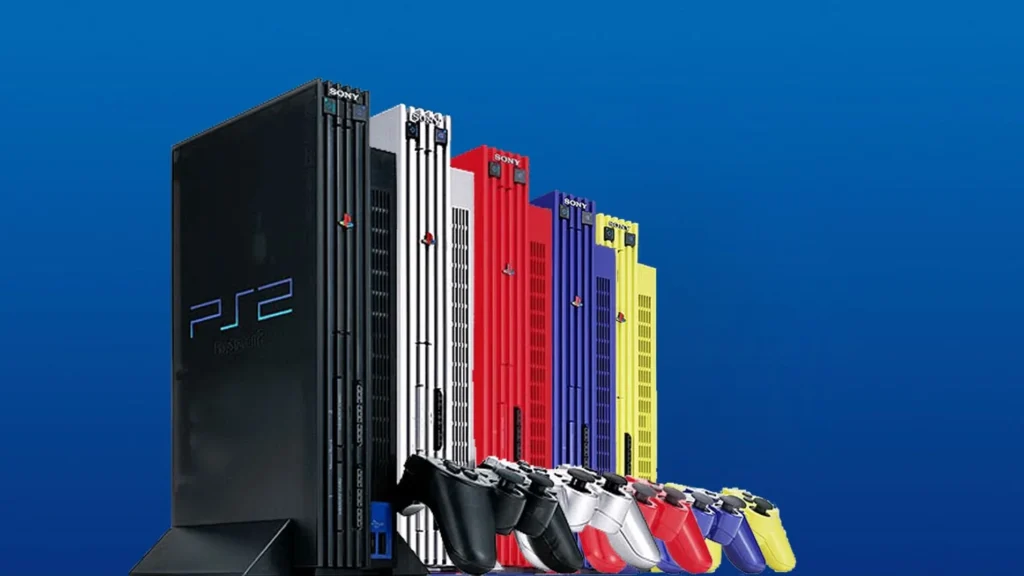
Launch, Market Dominance, and Competitive Landscape:
The PlayStation 2 (PS2) launched in Japan on March 4, 2000, at a price of ¥39,800. Its North American release followed on October 26, 2000, for US$299, and the European launch occurred on November 24, 2000, for £299. The PS2 entered the sixth generation of video game consoles, facing competition from the Sega Dreamcast (which had launched earlier), the Nintendo GameCube, and Microsoft’s newcomer, the Xbox.
The PS2 achieved immediate and overwhelming success. In Japan, it sold 1.4 million units by March 31, 2000, less than a month after its launch. The North American launch was similarly impactful, generating $250 million in sales of consoles, games, and accessories on its first day. The console’s impending release and strong early performance significantly impacted Sega Dreamcast sales, contributing to Sega’s decision to discontinue the Dreamcast in March 2001 and exit the hardware market.
The PS2’s market dominance was fueled by several key factors. The immense brand loyalty cultivated by the original PlayStation created a large, eager consumer base. Crucially, the PS2 included a built-in DVD player, a feature that made it an attractive proposition for home entertainment beyond just gaming, especially at a time when standalone DVD players were still relatively expensive. This broadened its appeal to a much wider audience. Furthermore, full backward compatibility with the vast library of PS1 games and controllers ensured a smooth transition for existing PlayStation fans and provided an extensive software lineup from day one. These elements, combined with Sony’s success in securing key exclusive or timed-exclusive titles like the Grand Theft Auto series and Metal Gear Solid 2: Sons of Liberty , made it exceedingly difficult for competitors to gain significant traction against the PS2’s momentum.
Technical Specifications & Hardware Innovations:
The PlayStation 2 represented a significant technological advancement over its predecessor.
CPU: At its heart was the 128-bit “Emotion Engine,” a custom processor developed jointly by Sony and Toshiba, clocked at approximately 300 MHz (specifically 294.912 MHz, with later models reaching 299 MHz). This CPU was comprised of eight distinct functional units integrated onto a single die, including a central MIPS R5900-based CPU core and two Vector Processing Units (VPUs), designed for complex floating-point calculations essential for 3D graphics and physics.
GPU: The graphics were handled by the “Graphics Synthesizer,” clocked at 147.456 MHz. It was capable of a theoretical peak fillrate of 2.4 gigapixels per second and could render up to 75 million polygons per second, though real-world performance with textures, lighting, and game logic was closer to 25 million polygons per second.
Memory: The system featured 32 MB of high-bandwidth RDRAM (Rambus DRAM) as its main memory, and 4 MB of embedded DRAM (eDRAM) serving as video RAM.
Sound: Audio capabilities included two 16-bit Sony SPU (Sound Processing Unit) cores, supporting a total of 48 channels of ADPCM audio, along with Dolby Digital 5.1 and DTS surround sound output.
Media: The PS2 utilized DVD-ROM as its primary media format for games, offering significantly more storage than CDs. It also maintained compatibility with PS1 CD-ROMs, audio CDs, and could play DVD films.
Key hardware innovations of the PlayStation 2 included:
Emotion Engine & Graphics Synthesizer: These custom-designed processors provided a substantial leap in graphical fidelity and processing power compared to the PS1, enabling more detailed game worlds, smoother animations, and more complex character models.
Integrated DVD Playback: This was a crucial feature that positioned the PS2 not just as a game console but as an affordable home entertainment hub, significantly broadening its market appeal.
Backward Compatibility: The PS2 offered full backward compatibility with the vast majority of original PlayStation games and controllers, providing immense value to consumers and ensuring a large playable library from launch.
Network Adaptor and Online Play: Although not available at launch, Sony later released a Network Adaptor (modem and Ethernet) for the PS2, introducing online gaming capabilities to the PlayStation ecosystem. This became a standard feature in later Slimline models.
USB Ports: The inclusion of USB ports allowed for the connection of various peripherals, most notably the EyeToy camera, which introduced novel motion-controlled gameplay experiences.
The PS2’s hardware strategy effectively balanced cutting-edge gaming technology with features that appealed to the mainstream consumer. The power of the Emotion Engine was heavily marketed, appealing to core gamers seeking advanced graphical experiences. Simultaneously, the built-in DVD player functionality provided a compelling value proposition for families and casual consumers looking for an affordable entry into home cinema. This multi-pronged approach to hardware features was a key differentiator from its competitors and a major contributor to its mass-market success, allowing it to become a central entertainment device in millions of households worldwide.
Key Peripherals:
The PlayStation 2’s functionality was expanded through a variety of peripherals:
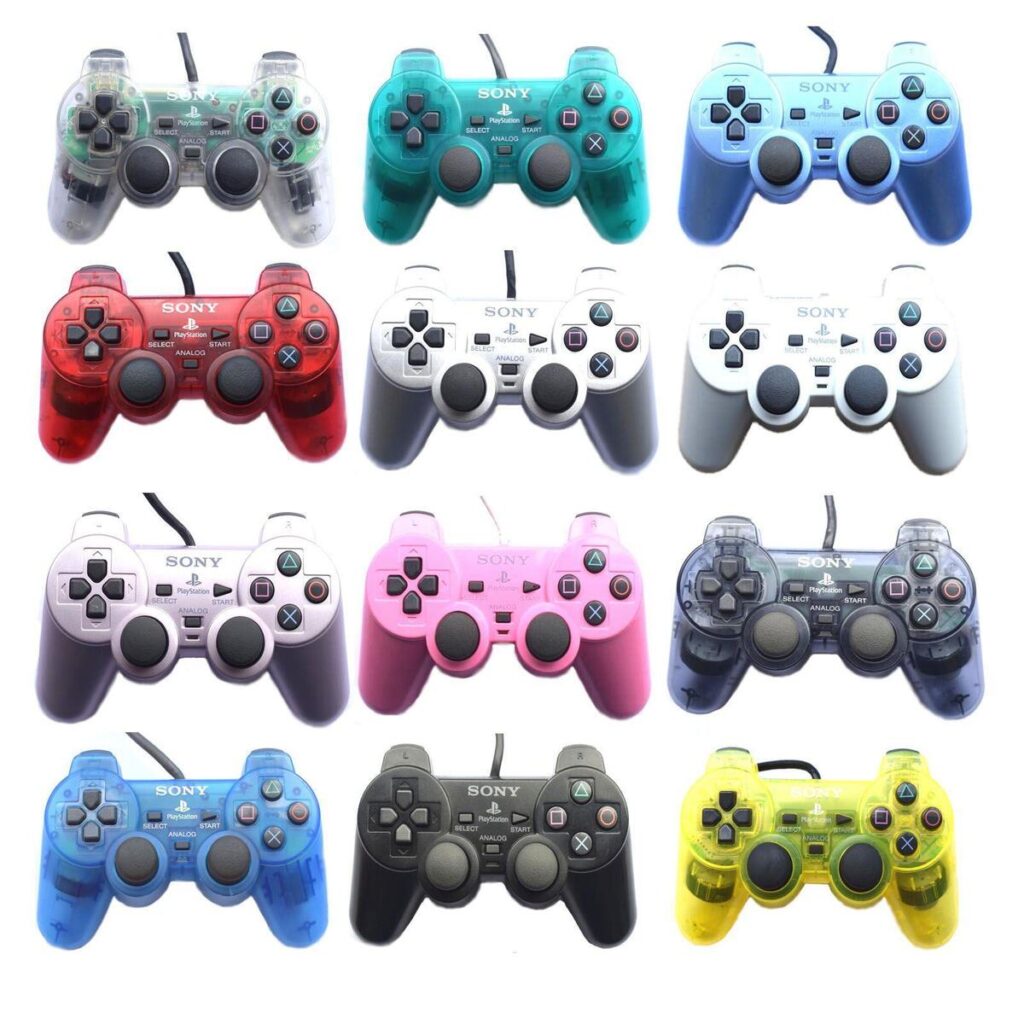
DualShock 2 Controller: This controller maintained the familiar design and form factor of the original DualShock but introduced analog face buttons, which offered pressure sensitivity for more nuanced input in compatible games. However, this analog sensitivity feature was not widely utilized by developers and rendered the controller incompatible with some PS1 games.
PlayStation 2 HDD (Hard Disk Drive): An optional 40 GB internal hard drive could be installed in an expansion bay on the original “fat” models of the PS2. This was required for certain games, such as Final Fantasy XI, and allowed for faster loading times and storage of game data or downloadable content in others.
Network Adaptor: Released in 2002, this peripheral provided Ethernet and/or modem connectivity, enabling online multiplayer for titles like SOCOM U.S. Navy SEALs and other online-enabled games. This feature was later integrated directly into the Slimline models of the PS2.
EyeToy: A USB digital camera device that enabled motion-controlled gameplay without a traditional controller. It captured the player’s image and allowed them to interact with on-screen elements through movement and gestures, proving popular with casual and family audiences.
Memory Card (8MB standard): Essential for saving game progress, the standard PS2 memory card utilized MagicGate encryption technology for data security. Larger capacity third-party memory cards also became available.
The introduction of peripherals like the Network Adaptor and the EyeToy for the PS2 indicated Sony’s early explorations into online connectivity and alternative input methods. While online gaming was not a central focus at the PS2’s launch, the subsequent release of the Network Adaptor was a strategic response to the growing importance of online multiplayer, a trend particularly highlighted by the launch of Microsoft’s Xbox and its Xbox Live service. The EyeToy, a precursor to later motion control systems like the Nintendo Wii Remote or Microsoft Kinect, demonstrated an early interest in more intuitive and family-friendly forms of interaction, thereby broadening the console’s appeal beyond traditional controller-based gaming and foreshadowing future industry trends.
Software Ecosystem: Defining Titles and Unrivaled Game Library:
The PlayStation 2’s software library was a monumental factor in its success, boasting an unparalleled number of titles and a vast diversity of genres. It amassed a global library of 10,987 game titles, with cumulative sales of 1.54 billion copies.
Key best-selling and iconic titles that defined the PS2 era include:

Grand Theft Auto series: Grand Theft Auto: San Andreas was the console’s best-selling game with 17.33 million units sold. Grand Theft Auto: Vice City (14.2M) and Grand Theft Auto III (11.6M) were also massive sellers and culturally significant titles that popularized open-world gameplay.
Gran Turismo series: Gran Turismo 3: A-Spec (14.89M) and Gran Turismo 4 (11.76M) continued the franchise’s legacy of realistic driving simulation and stunning graphics.
Final Fantasy series: Final Fantasy X sold 8.5 million units, and Final Fantasy XII sold 6 million, maintaining the franchise’s popularity.
Metal Gear Solid series: Metal Gear Solid 2: Sons of Liberty (7.03M) and Metal Gear Solid 3: Snake Eater (4M) were critically acclaimed stealth-action titles.
God of War series: God of War (4.61M) and God of War II (4.24M) introduced Kratos and became flagship action-adventure titles.
Other notable franchises and titles included Tekken 5 (6M) , Kingdom Hearts (5.9M) and Kingdom Hearts II (4.76M) , the Jak and Daxter series , the Ratchet & Clank series , Shadow of the Colossus , and Ico.
While the initial launch lineup for the PS2 was considered mediocre by some critics , partly due to the console’s complex architecture which presented a learning curve for developers, this situation improved dramatically by the 2001 holiday season with the release of several blockbuster games.
The unparalleled breadth and depth of the PS2’s software library, encompassing genres from action-adventure and role-playing games to racing simulations, fighting games, sports titles, and innovative party games utilizing the EyeToy, was the single most crucial factor in its sustained success and market dominance. While hardware features like DVD playback and backward compatibility provided initial appeal and value , it was the continuous stream of high-quality, often exclusive, games that fueled the PS2’s momentum for over a decade. This vast software support, from both Sony’s first-party studios and a wide array of third-party developers, created a powerful virtuous cycle: a larger game library attracted more players, which in turn incentivized more developers to create content for the platform, further expanding its appeal.
Market Performance, Record-Breaking Sales Figures, and Critical Reception:
The PlayStation 2 is the best-selling video game console of all time, with confirmed sales exceeding 160 million units worldwide. This sales figure nearly tripled the combined sales of its sixth-generation competitors (Xbox, GameCube, and Dreamcast). The PS2 dominated the sixth console generation, commanding a significant market share globally.
Upon its launch, the PS2 received widespread critical acclaim. Reviewers lauded its advanced hardware, particularly the Emotion Engine and Graphics Synthesizer, its impressive graphical capabilities for the time, its integrated DVD playback functionality (a significant value proposition), and its backward compatibility with the extensive library of original PlayStation games and hardware. While the initial game lineup was a point of criticism for some, this perception improved substantially as more high-quality titles were released. Later in its lifecycle, as newer consoles like the Xbox and GameCube emerged, some reviews noted the PS2’s comparatively weaker graphics performance in multiplatform titles, particularly concerning issues like aliasing (“jagged edges”). The Video Game Critic, in a retrospective review, awarded the PS2’s console design a B+/C, its graphics a B+, and its launch titles a C, while praising its vast game library (A-) and the utility of its DVD media format (A).
The PS2’s record-breaking sales were the result of a powerful confluence of factors. It inherited and built upon the strong brand legacy established by the original PlayStation. Its competitive launch price, especially when considering its dual functionality as a DVD player, made it an excellent value proposition for a wide range of consumers. Although the initial game library faced some criticism , it rapidly expanded to become the largest and most diverse of its generation, featuring numerous blockbuster hits and exclusive franchises. Sony’s marketing continued to target teenagers and adults effectively, further broadening its demographic appeal. This comprehensive appeal, rather than any single isolated factor, cemented the PlayStation 2’s status as the best-selling console in history and a cultural phenomenon.
The Slimline Model (2004) and Longevity:
In September 2004, Sony introduced a significantly redesigned version of the PlayStation 2, officially known as the Slimline (model series SCPH-70000, often referred to as “PSTwo”). This model was considerably smaller, thinner, and quieter than the original “fat” PS2. A key addition to the Slimline was a built-in Ethernet port for online play (some markets also included an integrated modem), making network connectivity more accessible. However, this redesign omitted the 3.5-inch expansion bay found in earlier models, thereby removing support for the internal hard disk drive. Later revisions of the Slimline model became even lighter.
Manufacturing of the PlayStation 2 officially ended in early 2013 (specifically, December 28, 2012, in Japan, and January 4, 2013, worldwide), granting it one of the longest operational lifespans in video game console history—over twelve years. Remarkably, new game releases for the platform continued until the end of 2013, with Pro Evolution Soccer 2014 being one of the last titles released in the United Kingdom on November 8, 2013. Repair services for the system in Japan concluded on September 7, 2018.
The introduction of the Slimline model and the sustained software support well into the subsequent console generation (the PlayStation 3 launched in 2006) demonstrate Sony’s strategic commitment to maximizing the PS2’s market penetration and operational lifespan. This approach catered effectively to late adopters, budget-conscious consumers, and emerging markets where the PS2 remained a viable and attractive gaming platform for many years. The Slimline’s more compact form factor and integrated networking made it an even more accessible and appealing option. The continued release of games, even after the PS3’s debut, ensured ongoing revenue streams and served the large, established user base that might not have been ready or able to upgrade to the newer, more expensive console immediately. This long-tail strategy significantly prolonged the PS2’s commercial viability and contributed to its record-breaking sales figures.
PlayStation 3 (PS3): The Multimedia Powerhouse (2006-2017)
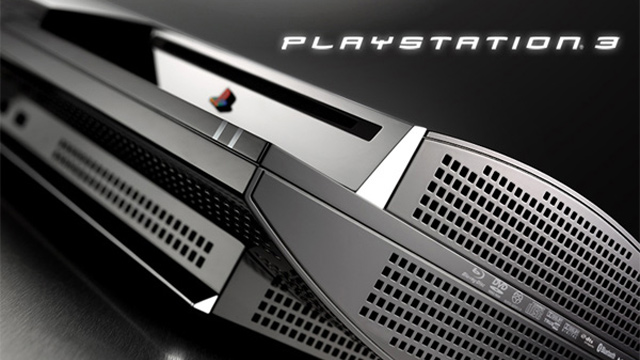
Launch Challenges, Market Context, and Competitive Landscape:
The PlayStation 3 (PS3) was launched in Japan on November 11, 2006, with the 20GB model priced at ¥49,980. Its North American release followed on November 17, 2006, where the 20GB model retailed for US$499 and a 60GB model for US$599. The console reached PAL regions, including Europe and Australasia, on March 23, 2007. The PS3 entered the seventh generation of video game consoles, competing directly with Microsoft’s Xbox 360, which had launched a year earlier in 2005 , and Nintendo’s Wii, which also launched in late 2006.
The launch of the PS3 was fraught with challenges and met with a mixed reception from both consumers and critics. A primary factor was its exceptionally high price point, which was considerably more expensive than its competitors. This high cost was largely attributed to its cutting-edge and complex internal architecture, particularly the custom-designed Cell Broadband Engine processor, and the inclusion of a Blu-ray Disc drive. The complexity of the Cell processor also posed a significant hurdle for game developers, leading to a relatively limited and, in some eyes, underwhelming selection of launch titles. Sony incurred substantial financial losses on each console sold for several years due to the high manufacturing costs; for instance, the 20GB model was estimated to cost Sony approximately US$805.85 to produce, resulting in a loss of about US$307 per unit sold at its $499 retail price. By mid-2008, Sony acknowledged cumulative losses on PS3 hardware amounting to around US$3.3 billion.
Sony’s vision for the PS3 as a “supercomputer for the living room” , equipped with the powerful Cell processor, was technologically ambitious. However, this ambition translated into a product that was initially difficult for developers to master and expensive for consumers to purchase. The Xbox 360’s year-long head start allowed it to establish a significant installed base and a more mature online ecosystem (Xbox Live) by the time the PS3 arrived. Simultaneously, the Nintendo Wii, with its innovative motion controls and lower price point, captured a vast casual gaming audience, disrupting the traditional console market. The PS3’s strategic inclusion of a Blu-ray drive, while crucial for Sony’s broader corporate goal of establishing Blu-ray as the dominant high-definition optical disc format (ultimately succeeding against HD DVD), further contributed to the console’s high initial retail price, placing it at a competitive disadvantage in the early stages of the console war.
Technical Specifications & Hardware Innovations:
The PlayStation 3 was engineered as a significant technological leap, incorporating several advanced components.
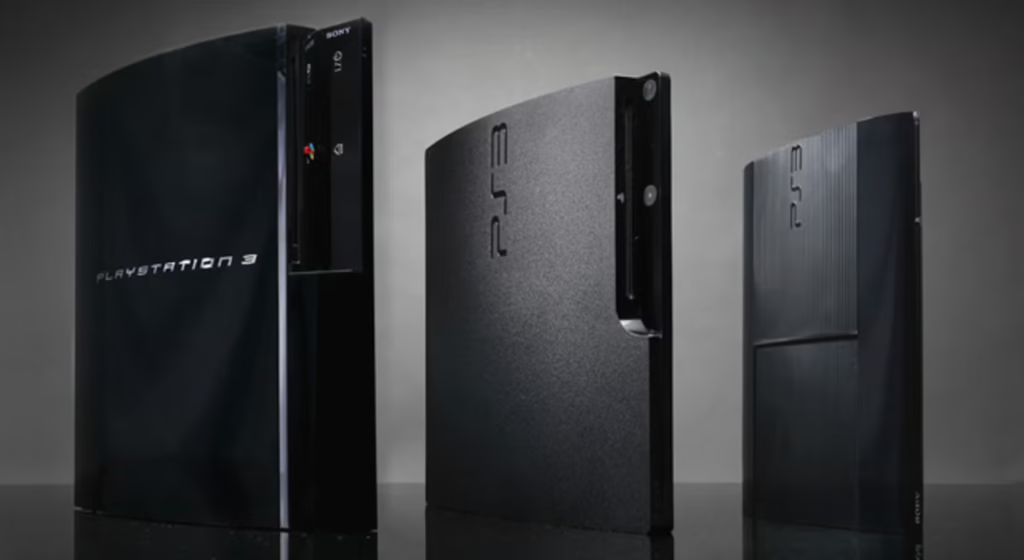
CPU: The centerpiece was the custom-developed Cell Broadband Engine, a multi-core processor architecture created in collaboration with Sony, Toshiba, and IBM (STI). It featured a 3.2 GHz PowerPC-based Power Processing Element (PPE) and eight Synergistic Processing Elements (SPEs). To maximize manufacturing yields and ensure consistency, one SPE was typically disabled, leaving seven active SPEs, with six available to game developers and one reserved for the operating system and security functions.
GPU: Graphics processing was handled by the RSX “Reality Synthesizer,” a GPU designed by Nvidia, clocked at 500 MHz (initially 550MHz). It was based on Nvidia’s GeForce 7 (NV47) architecture.
Memory: The system featured a split memory architecture with 256 MB of XDR Main RAM (clocked at CPU die speed) for the Cell processor and 256 MB of GDDR3 VRAM (clocked at 650 MHz) for the RSX GPU.
Media: The PS3 was the first console to incorporate a Blu-ray Disc drive as its primary storage medium for games, operating at 2x speed. It also supported playback of DVDs, CDs, and Super Audio CDs (SACDs) in early models.
Storage: All PS3 models included a 2.5-inch SATA hard disk drive (HDD), with initial capacities of 20 GB or 60 GB. Later models offered capacities up to 500 GB, and the “Super Slim” introduced a 16 GB eMMC flash storage option. The HDD was user-upgradeable across all models.
Connectivity: The PS3 offered robust connectivity options, including Gigabit Ethernet, built-in Wi-Fi (IEEE 802.11b/g, except for the original 20GB model), Bluetooth 2.0 (supporting up to seven devices), and multiple USB 2.0 ports (four in early models, two in later Slim and Super Slim models). Crucially, it was the first console to feature an HDMI output as standard. Early models also included flash card readers (Memory Stick, SD/MMC, CompactFlash).
Key hardware innovations for the PlayStation 3 were:
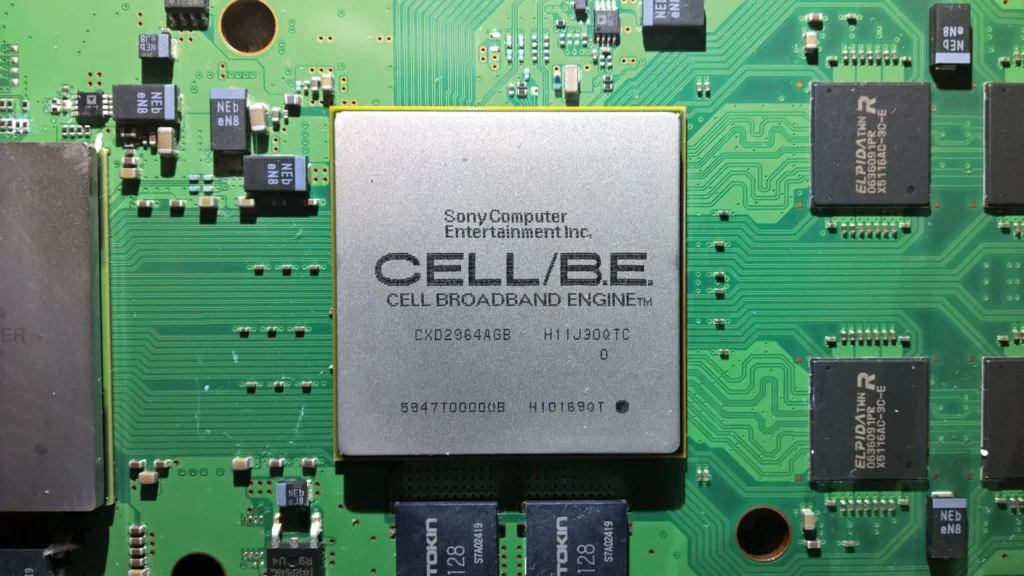
Cell Broadband Engine: A revolutionary and highly powerful processor architecture designed for complex parallel processing tasks. While its unique design initially posed a steep learning curve for developers, it enabled sophisticated physics, AI, and graphical effects in later-generation titles.
Blu-ray Disc Player: The PS3’s adoption of Blu-ray was a pivotal move. It provided significantly larger storage capacity (25GB single-layer, 50GB dual-layer) compared to DVDs, essential for high-definition games with extensive assets. This integration was also instrumental in Blu-ray’s victory over the competing HD DVD format in the high-definition optical disc format war.
HDMI Output and Full HD (1080p) Support: The PS3 was the first gaming console to standardize HDMI output and was capable of outputting games and movies in 1080p resolution, aligning with the rise of HDTVs.
PlayStation Network (PSN): Launched concurrently with the PS3, PSN provided a free online service for multiplayer gaming, digital game downloads via the PlayStation Store, messaging, and other online features. This was a significant differentiator from Xbox Live, which required a paid subscription for online multiplayer.
Wireless Controllers with Motion Sensing (Sixaxis/DualShock 3): The PS3’s launch controller, the Sixaxis, introduced motion-sensing capabilities. The later DualShock 3 controller re-integrated the popular vibration feedback feature while retaining motion control.
The PlayStation 3 represented a substantial technological leap, prioritizing high-definition media playback, immense processing power, and integrated online functionality. However, the very ambition of its technology led to a high initial cost and a period of adjustment for game developers. The Cell processor, while powerful, required developers to rethink their programming approaches to fully utilize its parallel processing capabilities, which initially hampered game development efficiency and multiplatform port quality. The inclusion of a Blu-ray drive was a long-term strategic victory for Sony in the broader home entertainment market but significantly contributed to the PS3’s high launch price, making it less competitive against the Xbox 360 and the mass-market appeal of the Nintendo Wii in its early years. Nonetheless, these advanced technologies also endowed the PS3 with a longer technological relevancy and established it as a versatile multimedia hub in many homes.
Key Peripherals:
The PlayStation 3 ecosystem was supported by several key peripherals that expanded its gameplay and interactive capabilities:
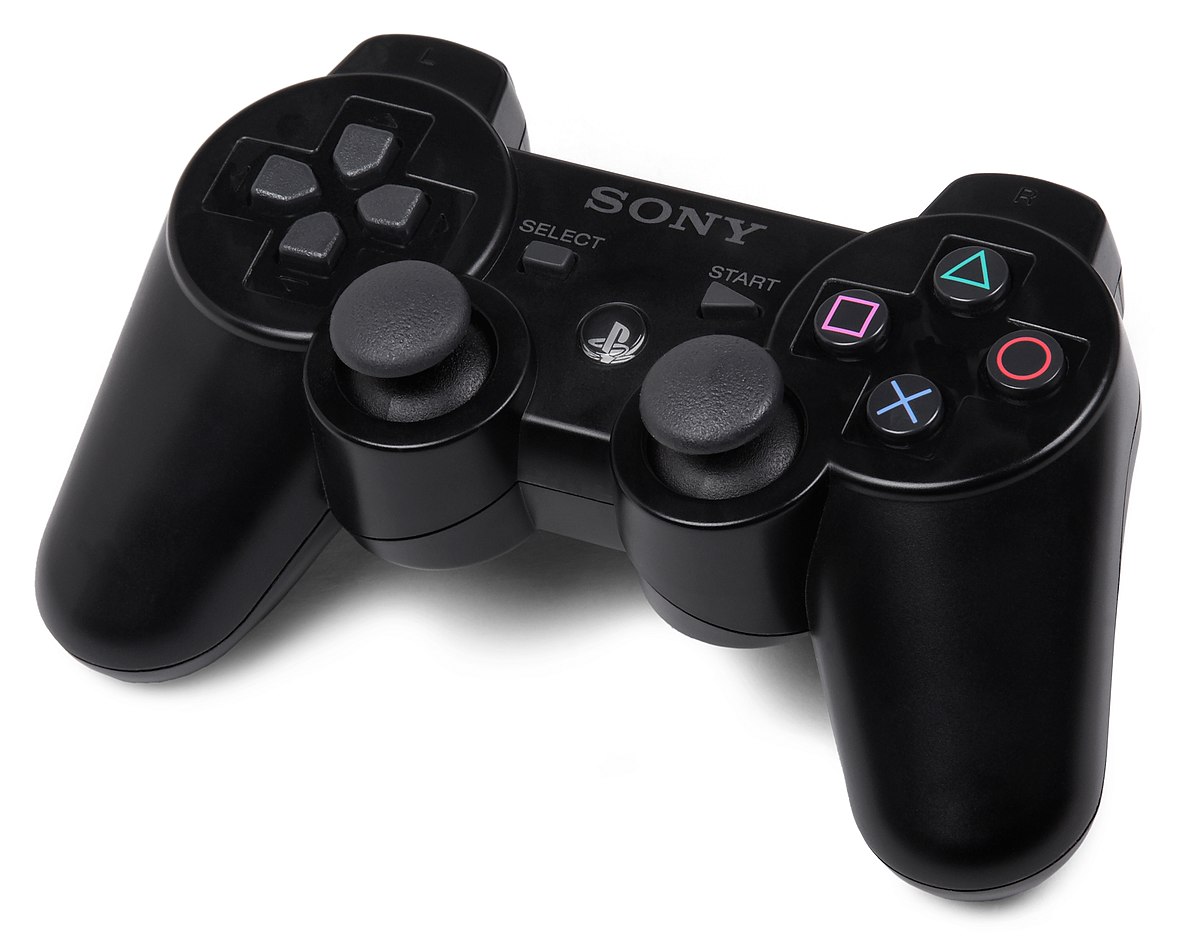
Sixaxis Wireless Controller (2006): This was the official launch controller for the PS3. It featured Bluetooth connectivity for wireless play and incorporated six-axis motion sensing technology, allowing players to control games through tilting and movement. However, it notably lacked the vibration feedback (rumble) feature that had been a staple of the DualShock controllers for the PS1 and PS2.
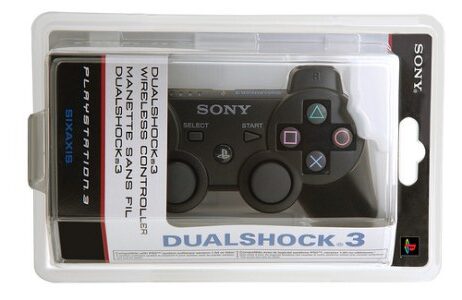
DualShock 3 Wireless Controller (2007/2008): Responding to consumer demand and resolving earlier patent disputes, Sony introduced the DualShock 3. This controller retained all the features of the Sixaxis, including motion sensing and wireless connectivity, but crucially re-integrated the popular haptic feedback (vibration) technology. It became the standard controller for the PS3 from late 2007 onwards.
PlayStation Eye (2007): A digital camera and microphone peripheral, succeeding the EyeToy for PS2. The PlayStation Eye was used for in-game motion tracking (often in conjunction with the PlayStation Move), augmented reality games, and video chat functionality on the PlayStation Network. [ (Implicitly, as PS Move requires it)]
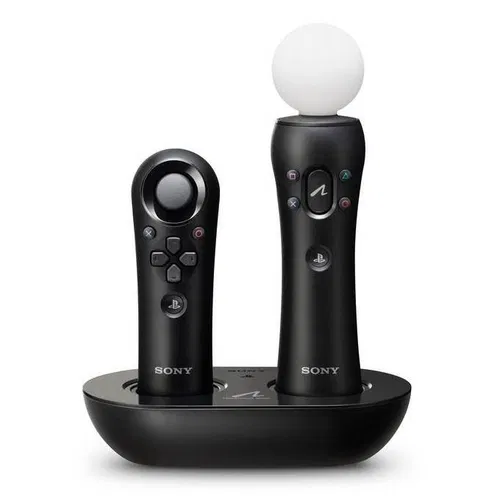
PlayStation Move (2010): Sony’s motion control system, launched to compete with the Nintendo Wii Remote and Microsoft Kinect. It consisted of a motion controller wand with an illuminated sphere, a navigation controller (optional, similar to the Wii Nunchuk), and required the PlayStation Eye camera for tracking. The PS Move offered precise motion tracking and was supported by a range of dedicated games and as an alternative control scheme in some traditional titles.
Sony’s peripheral strategy for the PS3, particularly with the introduction of the PlayStation Move, can be seen as largely reactive to the significant market trends established by its competitors. The initial omission of rumble in the Sixaxis controller was a point of contention for many users, eventually rectified with the DualShock 3. The PlayStation Move, while a technologically competent motion control solution, arrived relatively late in the console generation. By 2010, the motion control phenomenon initiated by the Nintendo Wii was already well-established, and Microsoft’s Kinect was offering a controller-free motion experience. This timing suggests Sony was playing catch-up in the motion control space during this generation, rather than leading with its own disruptive input innovations as it had previously done with the original DualShock controller.
Software Ecosystem: Exclusive Franchises, Multimedia Capabilities, and the XrossMediaBar (XMB):
Despite a challenging start, the PlayStation 3 eventually cultivated a robust software ecosystem, characterized by critically acclaimed exclusive franchises, extensive multimedia functionality, and an innovative user interface.
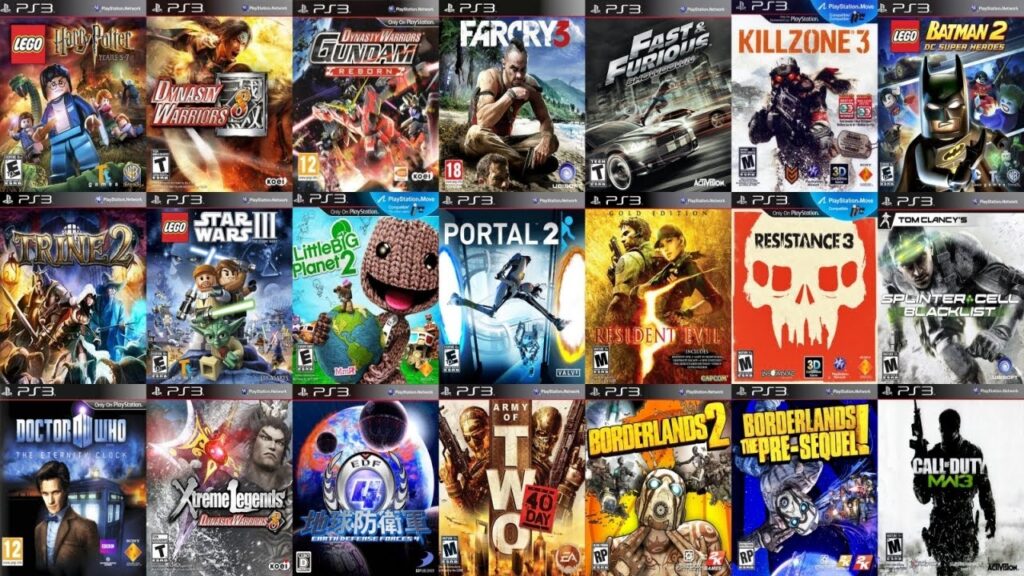
Iconic Exclusive Franchises: The PS3 became home to several highly regarded exclusive series and standalone titles that defined its later years. These included the Uncharted series (Drake’s Fortune, Among Thieves, Drake’s Deception) , The Last of Us , God of War III , Metal Gear Solid 4: Guns of the Patriots , the LittleBigPlanet series , Gran Turismo 5 and Gran Turismo 6 , Demon’s Souls , and the inFamous series. These titles often showcased the console’s processing power and were lauded for their narrative depth and technical achievements.
Multimedia Capabilities: A significant strength of the PS3 was its versatility as a multimedia device. Its Blu-ray drive made it an affordable high-definition movie player for many households. It also supported DVD and CD playback, media streaming applications (such as Netflix and YouTube, which became available over the console’s lifespan), photo viewing, and music ripping and playback from various sources.
XrossMediaBar (XMB): The PlayStation 3 utilized the XrossMediaBar as its graphical user interface. Originally introduced on the PSX DVR and later used on the PSP, the XMB provided an intuitive, horizontally scrolling category-based menu system for accessing games, videos, music, network services, and system settings. It was generally praised for its ease of navigation and clean design. The PS3’s XMB supported customizable themes, including dynamic themes that could change over time or react to user input, and allowed for in-game access to certain system functions (e.g., messaging friends, checking trophies) without quitting the game.
The PS3’s software strategy and multimedia features were pivotal in its eventual market recovery. The initial difficulty developers faced with the Cell processor led to a slower start for exclusive, system-selling titles compared to its competitors. However, as Sony’s first-party studios and other developers gained mastery over the hardware, they began to produce some of the most critically acclaimed and technically impressive games of that console generation. Titles like Uncharted 2: Among Thieves and The Last of Us were particularly lauded for pushing the boundaries of cinematic gaming. These high-quality exclusives, combined with the PS3’s robust capabilities as a Blu-ray player and comprehensive media center , gradually enhanced its value proposition. This, along with strategic price cuts and hardware revisions, helped the PS3 gain significant market share over time, demonstrating the importance of a strong software lineup and versatile functionality in a console’s long-term success. The XMB interface, while eventually superseded in later PlayStation consoles, was an innovative and largely well-received UI that effectively managed the PS3’s expanding range of features.
Market Performance, Sales Figures, and Evolving Critical Reception:
The PlayStation 3’s market journey was one of initial struggle followed by a significant recovery and eventual success. By March 31, 2017, the console had sold approximately 87.4 million units worldwide, narrowly surpassing the lifetime sales of its main competitor, the Xbox 360. Furthermore, as of early 2019, nearly 1 billion PlayStation 3 games had been sold globally, underscoring the platform’s extensive software adoption.
The critical reception of the PS3 at launch was decidedly mixed. Its high retail price (US$499 for the 20GB model and US$599 for the 60GB model in North America) was a major point of contention. The console’s complex Cell processor architecture, while powerful, presented a steep learning curve for developers, resulting in a limited selection of compelling launch titles. However, even early on, the PS3 was praised for its technological ambition, particularly its pioneering inclusion of a Blu-ray drive and its capacity for high-definition graphics.
Over time, the perception of the PS3 improved dramatically. This turnaround was driven by several factors: multiple strategic price reductions that made the console more accessible ; the victory of the Blu-ray format over HD DVD, which solidified the PS3’s value as a high-definition media player ; and, most importantly, the release of a growing library of critically acclaimed and commercially successful exclusive games. Illustrating this shift, Ars Technica’s review of the console evolved from a 6/10 rating at launch to a 9/10 rating in June 2008. While IGN ranked the PS3 as the 15th best gaming console of all time in September 2009 (behind both the Wii and Xbox 360 at that time), it also recognized the PS3 as having the best game lineup in 2008. The Metacritic user score for the PS3 hardware is 8.1 out of 10, categorized as “Generally Favorable,” based on user ratings.
The PS3’s lifecycle serves as a compelling case study in overcoming a challenging launch. The initial negative press and sales figures that lagged behind competitors compelled Sony to re-evaluate and adapt its strategy. Significant price cuts were implemented to make the console more competitive. The introduction of the Slim and Super Slim hardware revisions not only reduced manufacturing costs for Sony but also offered consumers more aesthetically pleasing and compact designs. Crucially, the consistent delivery of high-quality exclusive games, from both first-party studios and third-party partners, gradually won over both consumers and critics. The PS3’s journey underscores that a console’s ultimate success is not solely determined by its launch performance but can be significantly influenced by long-term strategic adjustments in pricing, hardware iteration, and, most critically, compelling software content.
Slim (2009) and Super Slim (2012) Revisions and Commercial Recovery:
Hardware revisions played a critical role in the PlayStation 3’s commercial recovery and extended lifecycle.
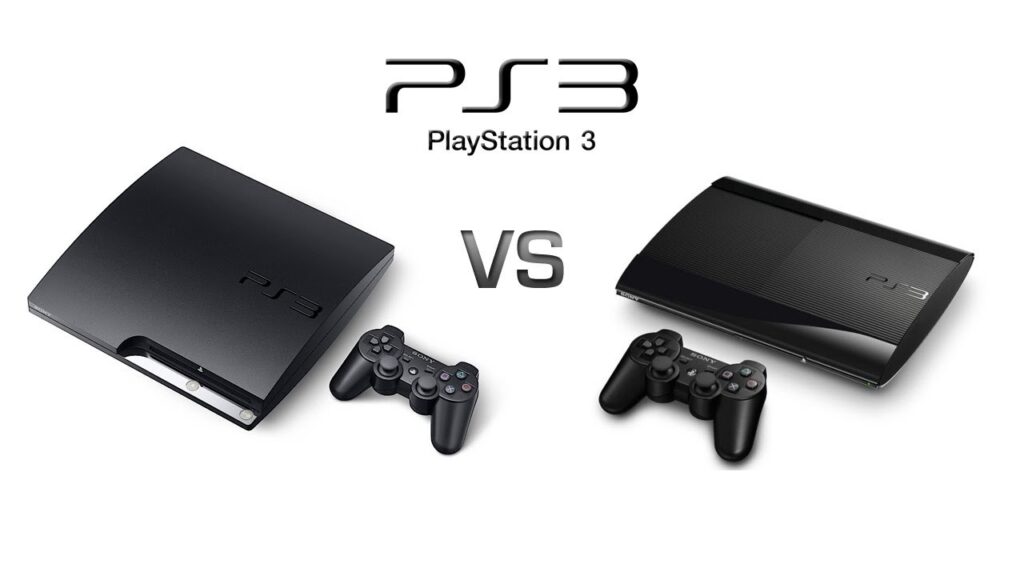
PS3 Slim (CECH-2000 series): Officially unveiled in August 2009 and launched in September 2009, the PS3 Slim was a significant redesign. It featured a considerably slimmer and lighter chassis compared to the original “fat” model. Internally, it incorporated a smaller, more power-efficient Cell processor (manufactured on a 45nm process), leading to reduced power consumption (by approximately 33%) and a quieter cooling system. The manufacturing costs for the Slim model were reportedly reduced by as much as 70% compared to the original, allowing Sony to introduce it at a more competitive price point of US$299. The PS3 Slim received overwhelmingly positive reviews from critics and consumers alike, and its launch provided a significant boost to PS3 sales.
PS3 Super Slim (CECH-4000 series): Launched in late 2012, the Super Slim model represented a further iteration focused on reducing size, weight, and manufacturing costs. It was approximately 20-25% smaller and lighter than the Slim model. A key design change was the replacement of the slot-loading Blu-ray drive with a manually operated top-loading sliding disc cover, which helped to further cut production expenses. The Super Slim was offered with larger hard drive capacities (such as 250GB and 500GB) and also introduced a budget-oriented model with 16GB of eMMC flash storage in some regions, with the option for users to install their own hard drive. While reviews for the Super Slim were generally positive, particularly praising its compact size and quiet operation, some critics found the top-loading disc mechanism to feel “fiddly” or “cheap” compared to the previous slot-loading drives.
These hardware revisions were instrumental in the PlayStation 3’s commercial turnaround. The original “fat” PS3 models were large, relatively noisy, and, most importantly, expensive for Sony to produce and for consumers to purchase. The PS3 Slim offered a much more appealing form factor at a crucial lower price, making the console significantly more competitive against the Xbox 360 and Wii. The subsequent Super Slim model further optimized production costs, enabling Sony to maintain profitability or minimize losses as the console matured and entered the later stages of its lifecycle. These iterative hardware improvements, combined with an increasingly strong and diverse library of exclusive games, were essential in transforming the PS3 from an initially struggling platform into a commercially successful console that ultimately surpassed its direct competitor in lifetime sales.
PlayStation 4 (PS4): The Resurgence (2013-Present)

Launch, Market Success, and Competitive Landscape:
The PlayStation 4 (PS4) was officially announced by Sony in February 2013 and subsequently launched in North America on November 15, 2013, at a retail price of US$399. European and Australian launches followed on November 29, 2013 (priced at €399 and £349 respectively), with Japan receiving the console on February 22, 2014 (¥39,980). The PS4 marked Sony’s entry into the eighth generation of video game consoles, where its primary competitors were Microsoft’s Xbox One and Nintendo’s Wii U, and later, the Nintendo Switch.
The PS4 experienced tremendous success from its launch. Sony reported over one million pre-orders for the console globally. In North America, it sold one million units within the first 24 hours of availability, making it the fastest-selling console in PlayStation history at that time. It also became the fastest-selling console ever in the United Kingdom, moving 250,000 units within 48 hours. By the end of 2013, just over a month after its initial launch in key Western markets, Sony had sold 4.2 million PS4 units worldwide. Throughout most of its generation, the PS4 consistently outsold its direct competitor, the Xbox One, establishing a significant market lead.
The remarkable success of the PS4 can be attributed to Sony effectively learning from the challenges faced during the PS3 era. A key strategic shift was the focus on a more developer-friendly architecture, moving away from the complex Cell processor. The console was launched at a competitive price point, US$100 cheaper than the Xbox One at its debut. Sony also garnered significant consumer goodwill through its clear and consumer-friendly policies regarding used games and digital rights management (DRM), which contrasted sharply with Microsoft’s initially controversial and restrictive policies for the Xbox One. This, combined with a perceived performance advantage in early multiplatform game comparisons, allowed the PS4 to build rapid and substantial market momentum from the outset.
Technical Specifications & Hardware Innovations:
The PlayStation 4’s architecture marked a significant departure from the PS3’s custom Cell processor, adopting a design more akin to contemporary personal computers.
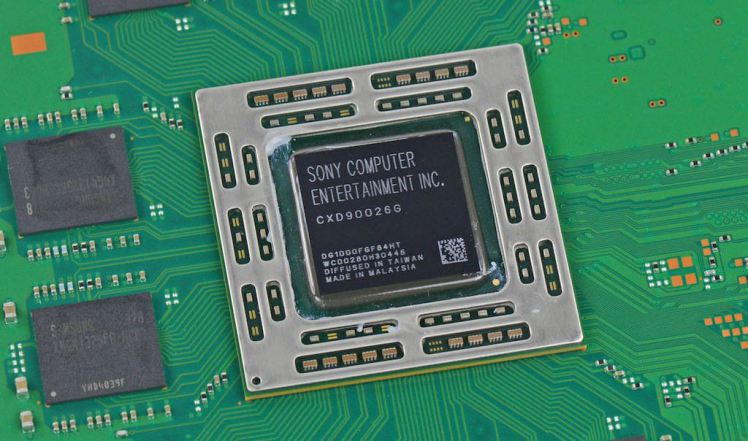
CPU: The console is powered by a semi-custom 8-core AMD Jaguar x86-64 Accelerated Processing Unit (APU). This APU integrates both the CPU and GPU onto a single chip. Seven of the eight cores are available for game developers.
GPU: The GPU is an AMD Radeon-based chip (Graphics Core Next architecture) with 18 compute units, delivering a theoretical peak performance of 1.84 TFLOPS.
Memory: A key feature is its 8 GB of GDDR5 unified RAM, shared between the CPU and GPU, providing a maximum memory bandwidth of 176 GB/s. This was a substantial increase over the PS3’s memory configuration.
Storage: The PS4 launched with a 500 GB mechanical hard disk drive (HDD), which is user-upgradable. Later models offered 1 TB HDDs, and System Software 4.50 (released March 2017) enabled support for external USB hard drives up to 8 TB.
Media: It features a Blu-ray Disc drive capable of reading discs at up to three times the speed of the PS3’s drive. It also supports DVD playback but notably does not play audio CDs.
Connectivity: The PS4 includes Wi-Fi (802.11 b/g/n on the original model, with 802.11ac added to the Slim and Pro models), Gigabit Ethernet, Bluetooth 2.1 (upgraded to 4.0 in Slim/Pro models), and two USB 3.0 ports (USB 3.1 in Slim/Pro). It also has an auxiliary port specifically for the PlayStation Camera, an HDMI output, and an optical S/PDIF audio output. Analog audio/video output was not included.
Display: The original PS4 model supports video output up to 1080p and 1080i. The PS4 Pro model supports 4K resolution output. All PS4 models support High Dynamic Range (HDR) color profiles via a firmware update.
Key hardware innovations for the PlayStation 4 include:
Shift to x86-64 Architecture: This move from the PS3’s complex Cell microarchitecture to a more familiar PC-like x86-64 architecture was a crucial decision. It significantly simplified the game development process for studios, making it easier and more cost-effective to create titles for the console and facilitating multiplatform development.
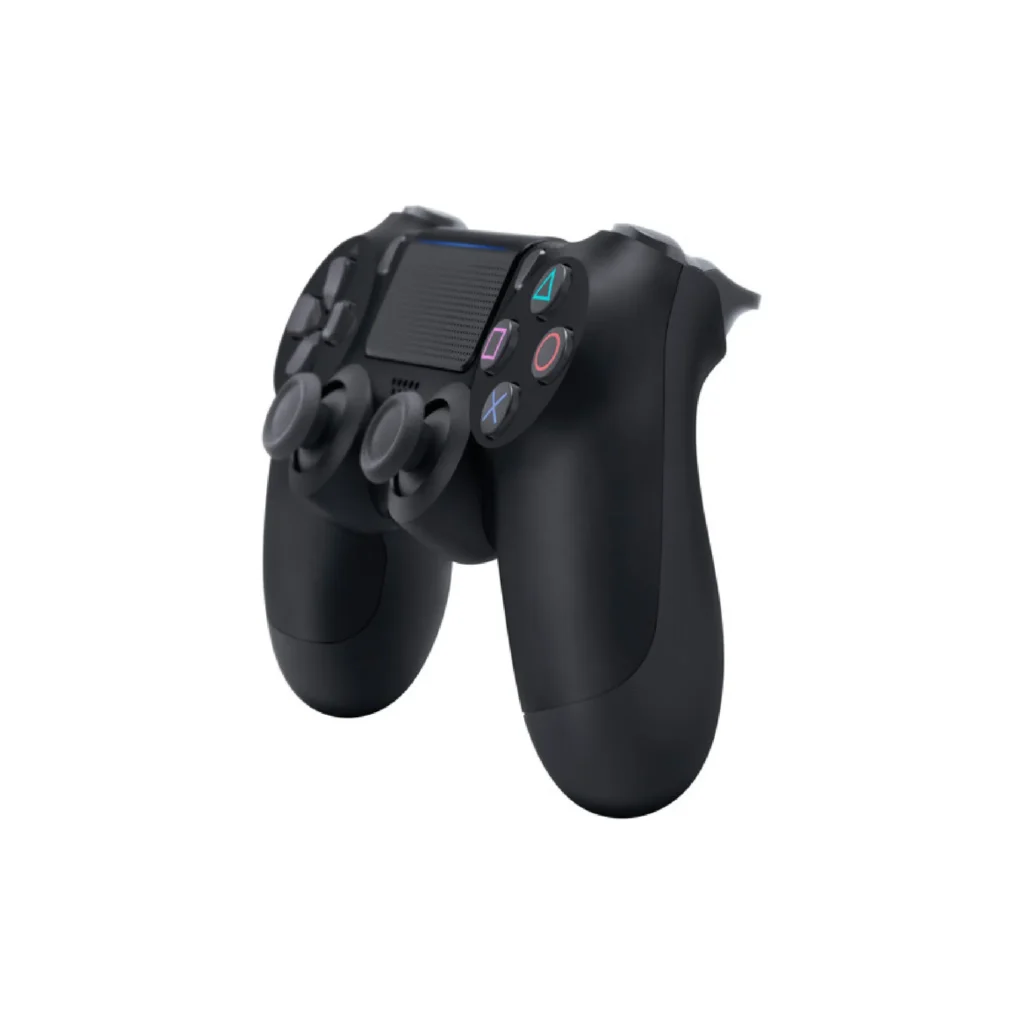
DualShock 4 Controller: The redesigned primary controller, the DualShock 4, maintained a similar ergonomic shape to its predecessors but introduced several new features. These included more concave analog stick caps for improved grip, refined trigger and shoulder buttons, a steeper D-pad angle for better precision, and thicker hand grips with microtexturing. Major additions were an integrated clickable touchpad capable of detecting two simultaneous touch presses, and a “Share” button, which replaced the “Select” button and provided instant access to social sharing features. It also featured an internal speaker, a stereo headphone jack, and an LED “light bar” used for motion tracking by the PlayStation Camera and for in-game visual feedback.
Emphasis on Social Interaction and Connectivity: The PS4 placed a strong emphasis on social features. The “Share” button allowed for easy capture and sharing of gameplay videos and screenshots. The console also supported live gameplay streaming to services like Twitch and Ustream (later YouTube Live), and featured Remote Play functionality, allowing users to stream PS4 games to a PlayStation Vita, and later to PCs, Macs, and compatible Xperia mobile devices.
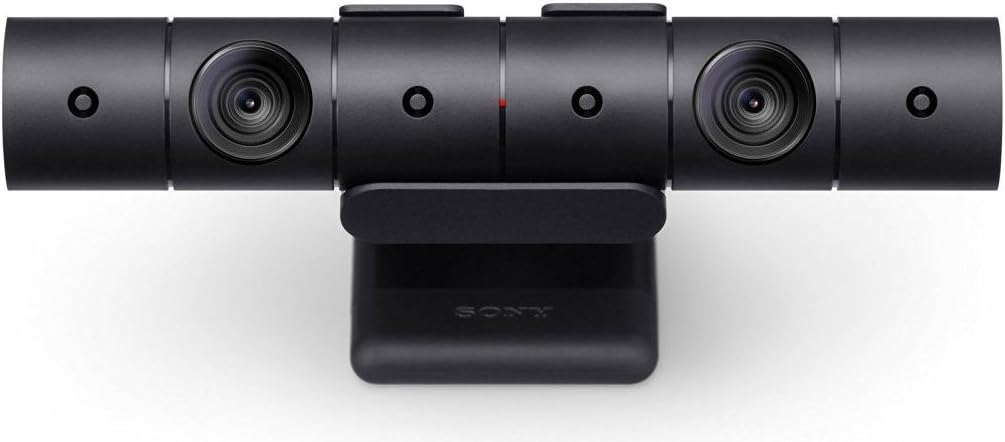
PlayStation Camera: An optional, redesigned motion sensor and camera device, featuring two 1280×800 pixel lenses for depth-sensing and motion tracking of the DualShock 4’s light bar and PlayStation Move controllers. It also included a four-channel microphone array for voice commands and noise reduction and supported face detection for user log-on.
Rest Mode: This low-power standby state allowed the console to download game updates and system software in the background, charge controllers, and enable users to quickly resume their games or applications from where they left off.
HDR Support: High Dynamic Range color output was added to all PS4 models via a system software update, enhancing visual fidelity on compatible displays by providing a wider range of colors and contrast.
The architectural philosophy of the PS4 represented a strategic pivot towards greater ease of development and deeper integration of social features, reflecting the evolving landscape of player behavior and industry trends. The adoption of the x86 architecture was a direct lesson learned from the developmental complexities of the PS3’s Cell processor, aimed at attracting broader and more immediate developer support and streamlining the creation of multiplatform games. The prominent “Share” button and built-in streaming capabilities were a clear acknowledgment of the burgeoning popularity of social media platforms and game streaming services like Twitch, transforming content sharing from a niche activity into a core, easily accessible component of the console experience. Furthermore, the expansion of Remote Play sought to create a more integrated ecosystem, particularly with the PlayStation Vita, although the handheld’s own market challenges somewhat limited the widespread impact of this specific cross-platform feature.
Key Peripherals:
The PlayStation 4 was accompanied by several key peripherals designed to enhance the gaming experience and introduce new forms of interaction:
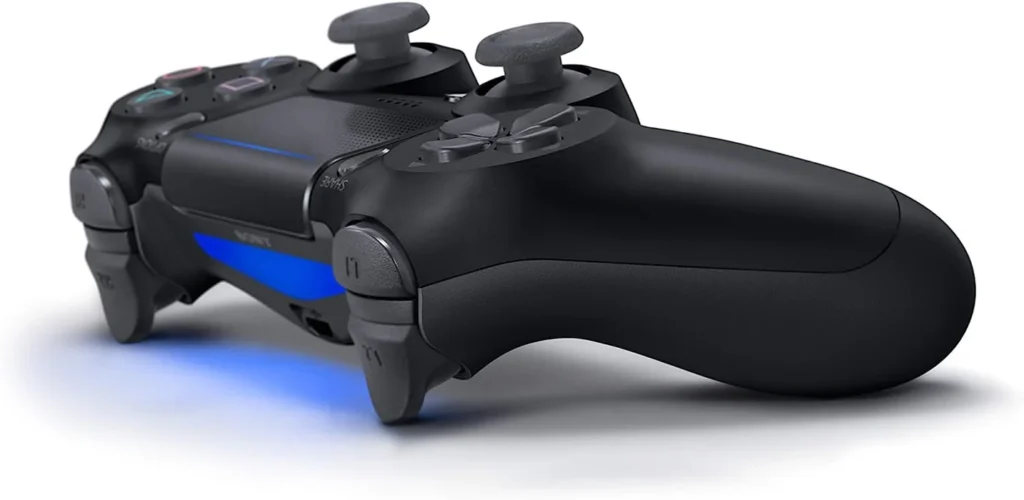
DualShock 4 Controller: This was the primary controller for the PS4. It featured a refined ergonomic design, improved analog sticks and triggers, a clickable multi-touch touchpad on its face, an integrated light bar for tracking by the PlayStation Camera and in-game feedback, a built-in mono speaker, a stereo headset jack, and the significant addition of a “Share” button for instant gameplay capture and social sharing.
PlayStation Camera: An optional accessory, the PlayStation Camera was a redesigned motion sensor and camera device. It featured dual lenses for stereoscopic depth perception, enabling it to track the DualShock 4 controller’s light bar, PlayStation Move motion controllers, and the PlayStation VR headset. It also included a four-microphone array for voice commands and could be used for facial recognition log-in and broadcasting gameplay with picture-in-picture video.
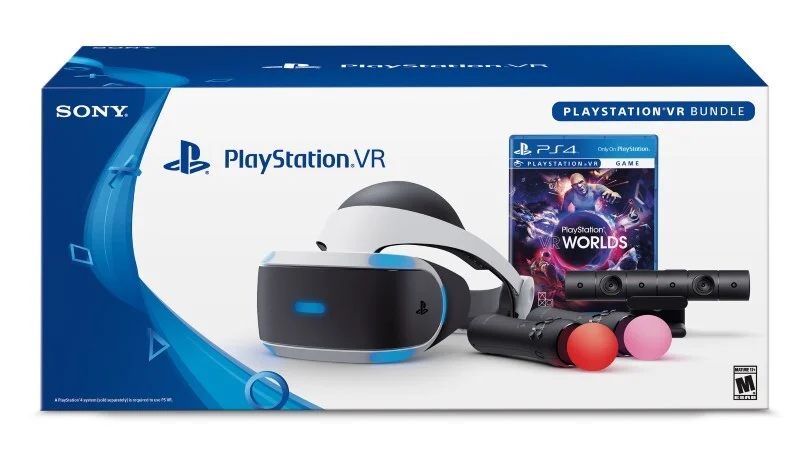
PlayStation VR (PSVR): Launched in October 2016, PlayStation VR was Sony’s virtual reality system designed specifically for the PS4. It consisted of a headset with a 5.7-inch OLED display (1920×1080 resolution, 960×1080 per eye), LED lights for tracking by the PlayStation Camera, and an external processor unit for 3D audio processing and managing the “Social Screen” output to a TV.
The “Share” button on the DualShock 4 controller stands out as a simple yet profoundly impactful innovation. It directly tapped into the burgeoning online culture of game sharing, streaming, and community engagement. In previous console generations, capturing and sharing gameplay experiences was often a cumbersome, multi-step process requiring external hardware. The dedicated “Share” button on the DualShock 4 streamlined this process dramatically, allowing players to effortlessly save screenshots, record video clips, and broadcast their gameplay live to platforms like Twitch and YouTube. This design choice recognized and catered to a significant shift in player behavior, where gamers were increasingly becoming content creators and active participants in online communities. By making social interaction an integral and easily accessible part of the PS4 experience, Sony significantly enhanced the console’s appeal in a socially connected world.
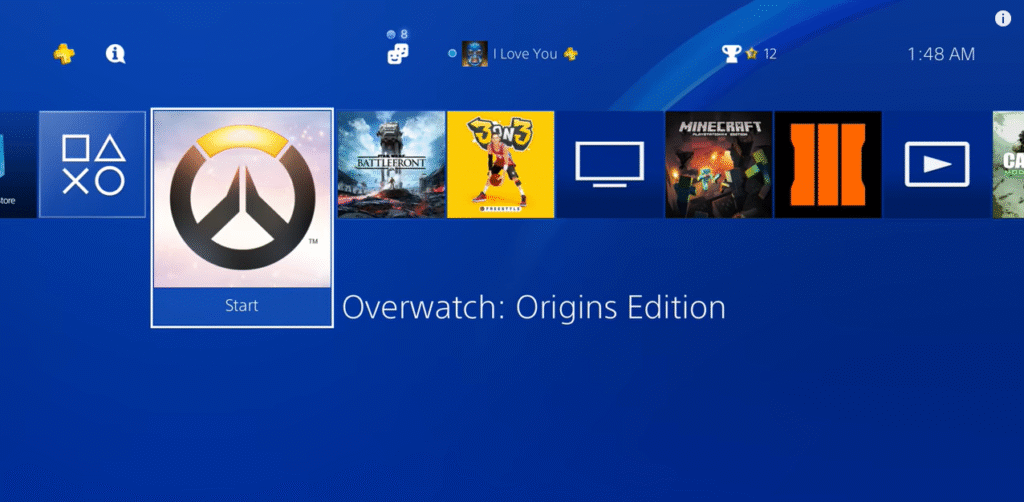
Software Ecosystem: Critically Acclaimed Exclusives, Strong Indie Developer Support, and User Interface:
The PlayStation 4’s software ecosystem was a major driver of its success, characterized by a strong lineup of critically acclaimed first-party exclusives, robust support for independent developers, and an evolved user interface.
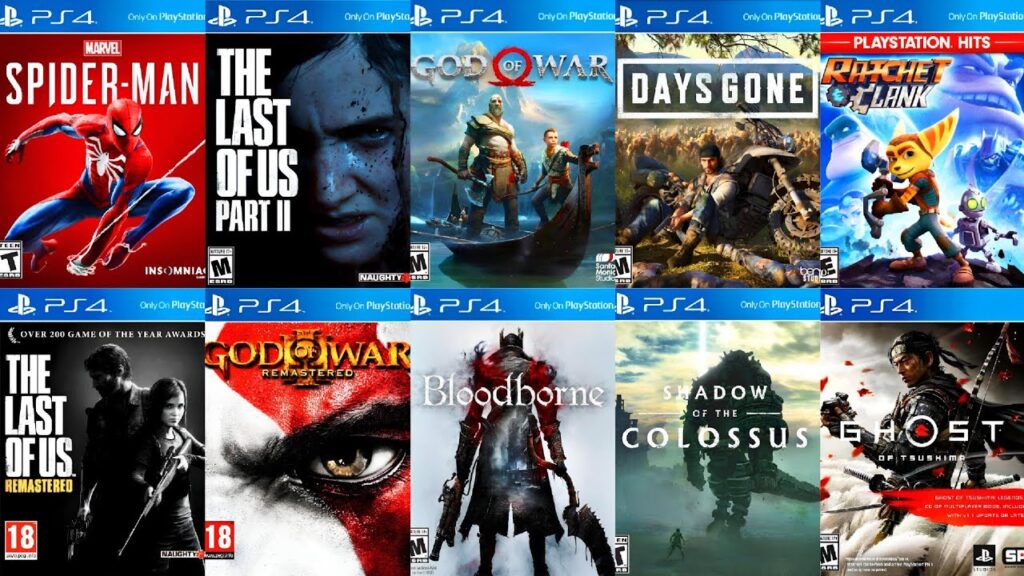
Critically Acclaimed Exclusives: The PS4 boasted numerous exclusive titles that garnered both critical praise and commercial success. Among the best-selling and most iconic were Marvel’s Spider-Man (the platform’s top seller with 22.68 million copies sold) , God of War (2018) (21.02M) , Uncharted 4: A Thief’s End (18.65M) , Horizon Zero Dawn (19.29M) , The Last of Us Remastered (18.63M) , Bloodborne , and Ghost of Tsushima. These games were often lauded for their storytelling, graphical fidelity, and engaging gameplay.
Indie Developer Support: Sony actively cultivated a welcoming environment for independent game developers on the PS4, notably allowing them to self-publish their titles on the PlayStation Store. This policy fostered a vibrant indie scene on the platform, leading to a diverse range of innovative and unique games.
User Interface (PlayStation Dynamic Menu): The PS4’s user interface, known as the PlayStation Dynamic Menu, was an evolution from the PS3’s XrossMediaBar. It focused on social discovery, content curation, and ease of access to games, applications, and system features. While generally well-received for its overall functionality and speed, some contemporary reviews noted that the initial software lacked certain features present on the PS3 (like folders for organizing content, which were added later) and that some of the DualShock 4’s distinctive features, such as the touchpad, were underutilized in many early games. The Video Game Critic, for instance, rated the PS4’s software functionality a ‘D’ due to mandatory game install times and system updates, though acknowledged the interface made library perusal easy once games were installed.
The PS4’s software strategy successfully balanced the production of high-budget, blockbuster first-party exclusives with the nurturing of a thriving independent game development scene. This dual approach created a diverse and appealing game library that catered to a wide spectrum of player tastes and preferences. High-quality exclusives like God of War and Marvel’s Spider-Man served as system-sellers and critical darlings, showcasing the console’s capabilities. Simultaneously, Sony’s more open and supportive policy towards indie developers led to a rich ecosystem of creative and unique titles, differentiating the PS4 from competitors that may have had a more restrictive or less accessible platform for smaller studios. This ensured a consistent and varied flow of content throughout the console’s lifecycle, contributing significantly to its sustained popularity.
Market Performance, Sales Figures, and Widespread Critical Acclaim:
The PlayStation 4 achieved remarkable market performance, selling over 117.2 million units worldwide as of March 2022. This sales figure establishes it as the second best-selling PlayStation home console, surpassed only by the PlayStation 2, and positions it as one of the best-selling video game consoles of all time.
The console was released to critical acclaim, with reviewers and developers alike praising Sony for its responsiveness to consumer needs, its embrace of independent game development, and its decision not to impose the restrictive digital rights management (DRM) schemes that Microsoft had initially announced for the Xbox One. The PS4’s hardware capabilities were also widely lauded by critics and third-party studios prior to its launch. However, some hardware-focused reviews, like that from The Video Game Critic, were more mixed, praising aspects like graphics and quiet operation (rated ‘A’) but heavily criticizing hardware functionality (rated ‘F’ due to button design and power-off procedures) and the controller design (rated ‘D’). The Metacritic user score for the PS4 hardware is a 4.5 out of 10 (“Generally Unfavorable”), though this is based on a very small sample of only 10 user ratings and may not be representative of broader consumer sentiment.
The PS4’s market dominance throughout the eighth console generation was a direct result of Sony astutely learning from the missteps of the PS3 era. By offering a powerful console with a developer-friendly architecture at a competitive price point (launching $100 cheaper than the Xbox One ), Sony gained an immediate and significant advantage. This was further amplified by consumer-friendly policies regarding game ownership and a strong pipeline of exclusive, high-quality games that resonated with a global audience. Microsoft’s initial public relations stumbles concerning DRM and “always-online” requirements for the Xbox One also played a role in ceding early momentum to Sony. This strong start, sustained by a consistent stream of compelling software and effective marketing, solidified the PS4’s position as the leading console of its generation.
Slim (2016) and Pro (2016) Model Iterations:
In September 2016, Sony introduced two hardware revisions for the PlayStation 4:
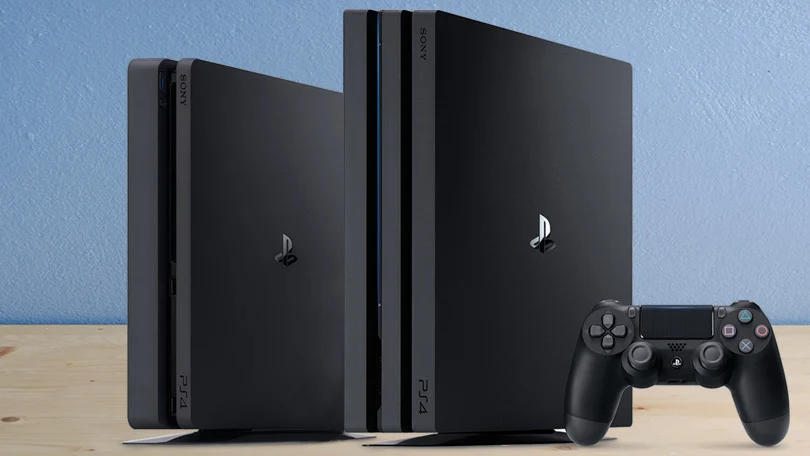
PlayStation 4 Slim (CUH-2000 series): Launched on September 15, 2016, the PS4 Slim was a smaller, lighter, and more power-efficient version of the original PS4 model, eventually phasing out the launch console. It featured a more rounded chassis and incorporated some technical updates, including support for 5GHz Wi-Fi (802.11ac), USB 3.1 ports, and Bluetooth 4.0. However, it notably removed the optical audio port found on the original model.
PlayStation 4 Pro (CUH-7000 series): Launched on November 10, 2016, the PS4 Pro was a higher-end model designed to offer enhanced performance. It featured an upgraded GPU with 4.2 teraflops of processing power (more than double the original PS4’s GPU) and a higher CPU clock rate. These improvements enabled support for 4K resolution rendering (often using checkerboard techniques) for compatible games, improved PlayStation VR performance, and enhanced visuals or frame rates for “PS4 Pro Enhanced” titles on 1080p displays. Like the Slim, it included updated USB 3.1, Bluetooth 4.0, and 5.0 GHz Wi-Fi. Despite its 4K capabilities for gaming and video streaming, the PS4 Pro did not include an Ultra HD Blu-ray drive, a decision that drew some criticism.
The introduction of these mid-generation hardware refreshes represented an evolution in Sony’s console strategy. The PS4 Slim followed the established pattern of offering a more compact and cost-effective version of the base console, appealing to new buyers and those prioritizing a smaller footprint. The PS4 Pro, however, was a new approach for the PlayStation brand, introducing a premium, more powerful iteration within the same console generation. This tiered strategy aimed to cater to different segments of the market: the Slim for budget-conscious consumers and the Pro for enthusiasts seeking the best possible visual fidelity, particularly those with 4K televisions or PlayStation VR headsets. This approach helped to extend the PS4’s overall lifecycle and maintain its appeal against evolving display technologies and consumer expectations for performance.
PlayStation 5 (PS5): Defining the Next Generation (2020-Present)
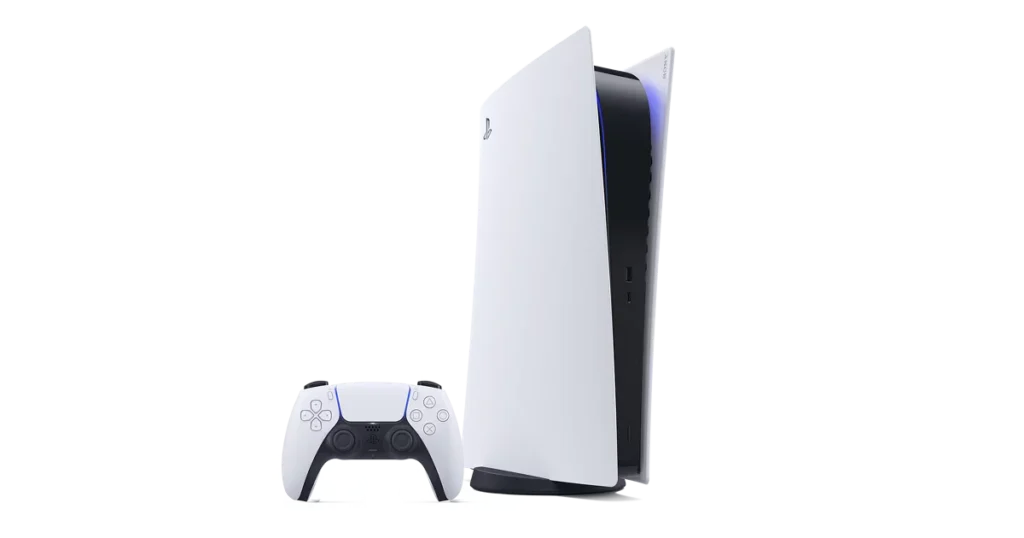
Launch Amidst Global Supply Constraints, Market Context, and Competitive Landscape:
The PlayStation 5 (PS5) was launched by Sony Interactive Entertainment in select major markets, including North America, Japan, Australia, New Zealand, and South Korea, on November 12, 2020. A wider global release followed on November 19, 2020. The console’s launch marked the beginning of the ninth generation of video game consoles, where its primary competitor is Microsoft’s Xbox Series X and Series S.
The PS5’s launch period and subsequent years were significantly impacted by unprecedented global semiconductor shortages and logistical challenges exacerbated by the COVID-19 pandemic. This led to severe supply constraints, making the console extremely difficult for consumers to purchase at retail price for an extended period, often through 2021 and into 2023. Despite these significant supply issues, Sony reported that the PS5 had the largest launch in PlayStation history, surpassing the initial sales of the PS4.
The circumstances surrounding the PS5’s launch were unique, characterized by immense consumer demand driven partly by increased time spent at home due to the pandemic, clashing with severe global supply chain disruptions. This “perfect storm” resulted in widespread stock shortages, a thriving reseller market (scalping), and considerable consumer frustration. The situation underscored the intricate vulnerabilities of global manufacturing and supply networks and highlighted the immense logistical hurdles involved in launching a major consumer electronics product during a worldwide crisis.
Technical Specifications & Hardware Innovations:
The PlayStation 5 represents a significant leap in hardware capabilities compared to its predecessor.
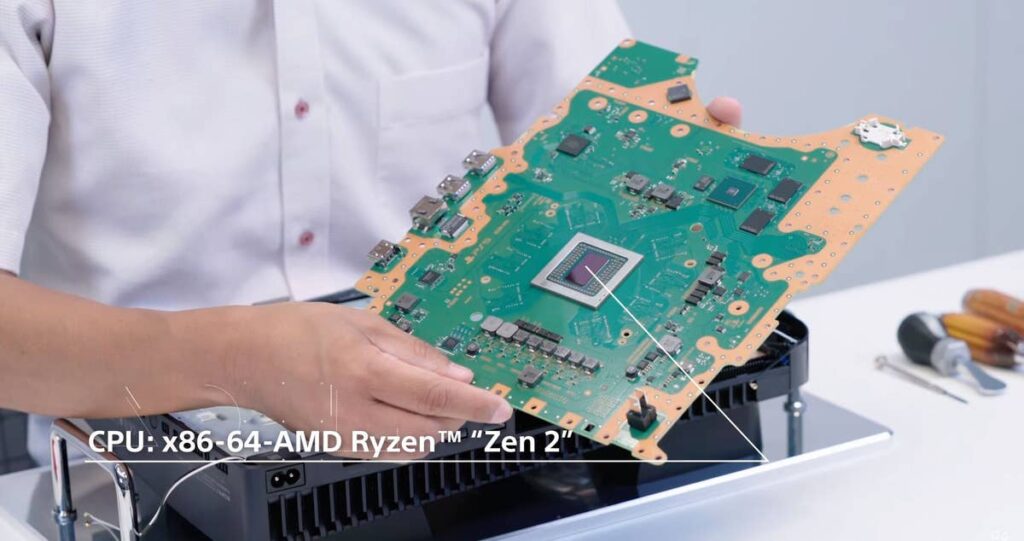
CPU: It features a custom 8-core AMD Zen 2 microprocessor with a variable clock frequency of up to 3.5 GHz.
GPU: The custom GPU is based on AMD’s RDNA 2 architecture, featuring 36 compute units operating at a variable frequency of up to 2.23 GHz. This provides a theoretical peak performance of 10.28 TFLOPS.
Memory: The console is equipped with 16 GB of GDDR6 SDRAM, connected via a 256-bit interface, achieving a peak memory bandwidth of 448 GB/s. This unified memory pool is shared between the CPU and GPU.
Storage: A cornerstone of the PS5’s design is its custom ultra-high-speed 825 GB NVMe SSD (Solid State Drive). This SSD provides raw read bandwidth of 5.5 GB/s, with typical compressed throughput estimated at 8–9 GB/s, and can peak at 22 GB/s thanks to a dedicated decompression unit supporting zlib and Oodle Kraken formats. The system includes an internal M.2-format SSD slot that supports user-installed NVMe drives up to 8 TB for storage expansion (667 GB is available to the user from the internal drive for game installation). Later Slim models feature a 1TB SSD.
Media: The standard PS5 model includes an Ultra HD Blu-ray drive compatible with 4K Blu-ray discs. A Digital Edition was launched simultaneously without an optical drive.
Display Output: The PS5 supports a range of resolutions including 720p, 1080i, 1080p, 1440p, 4K (2160p), and is capable of 8K output. It supports refresh rates up to 120Hz for smoother gameplay.
Audio: It features a new proprietary audio processing system called the Tempest Engine (or Tempest 3D AudioTech), designed to support hundreds of simultaneous sound sources for highly immersive 3D audio experiences. It also supports Dolby Atmos and 7.1 surround sound.
Connectivity: The PS5 supports Bluetooth 5.1 and Wi-Fi 6 (IEEE 802.11ax). It also includes a Gigabit Ethernet port, three USB 3.2 Gen 2×1 Type-A ports, one USB 2.0 Type-A port, and one HDMI 2.1 port.
Key hardware innovations of the PlayStation 5 include:
Custom NVMe SSD: This is arguably the most significant innovation, designed for extremely high-speed data streaming. It dramatically reduces or eliminates game loading times and allows developers to design games with larger, more detailed, and seamlessly streamed environments, addressing a key bottleneck identified during development.
Hardware-Accelerated Ray Tracing: The RDNA 2-based GPU supports real-time ray tracing, a computationally intensive rendering technique that simulates the physical behavior of light, resulting in more realistic lighting, shadows, and reflections in supported games.
Tempest 3D AudioTech: This dedicated audio processing engine enables sophisticated and precise 3D audio positioning, allowing for hundreds of simultaneous sound sources to create a more immersive and spatially aware soundscape for players using compatible headphones or speaker setups.
DualSense Wireless Controller: A revolutionary controller featuring advanced haptic feedback, adaptive triggers that provide variable resistance, a built-in microphone array, and an improved speaker.
High Frame Rate and Resolution Support: The PS5 supports gaming at 4K resolution up to 120 frames per second (fps) and is capable of 8K output, providing smoother and more visually detailed experiences on compatible displays.
The core technological advancements of the PS5—particularly its ultra-fast SSD, the innovative DualSense controller, and the Tempest 3D Audio engine—collectively aim to significantly enhance player immersion and reduce common points of friction, such as lengthy loading times. These features represent a substantial leap in the sensory experience of gaming, moving beyond mere graphical improvements to create more tactile, responsive, and aurally rich interactive worlds. The SSD, in particular, is transformative, fundamentally altering how game data is accessed and streamed, which allows for new game design paradigms previously unachievable due to storage speed limitations.
Key Peripherals:
The PlayStation 5 is supported by a new generation of peripherals designed to complement its advanced capabilities:
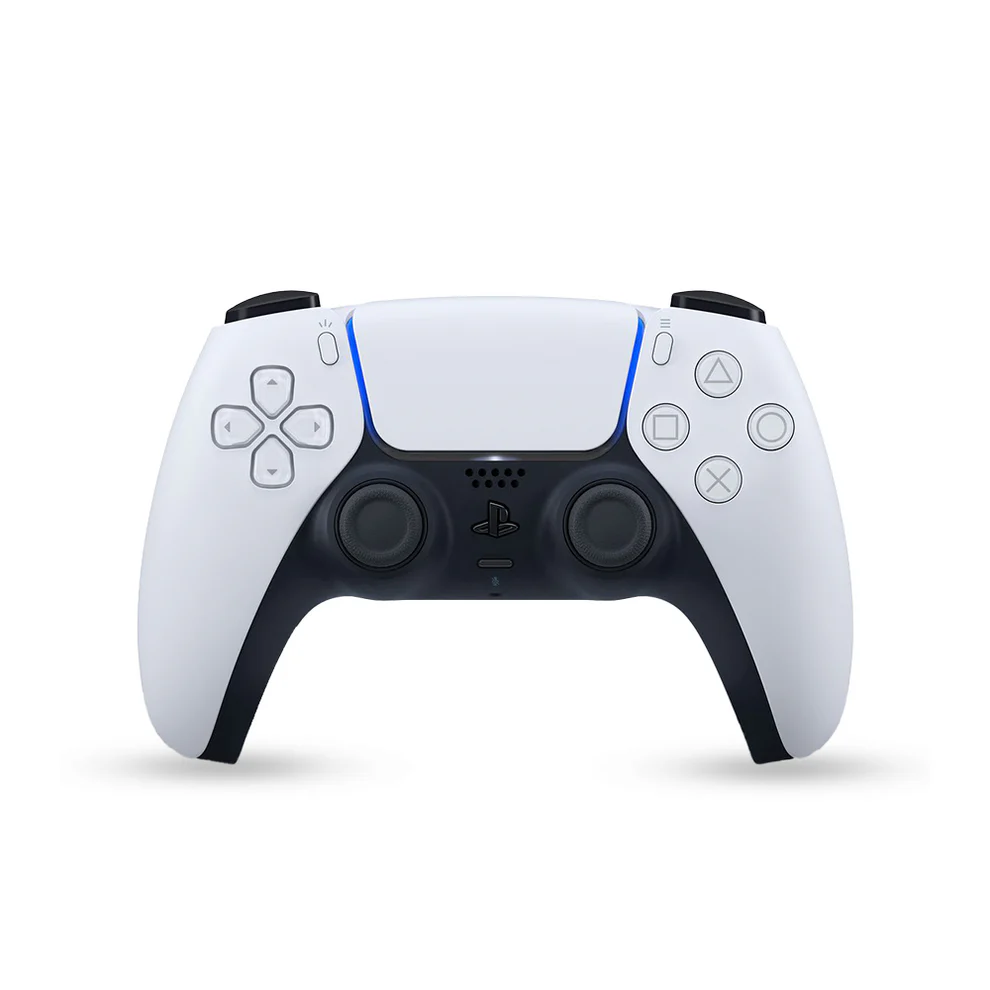
DualSense Wireless Controller: This is the standard controller bundled with the PS5. It is a significant evolution from the DualShock 4, featuring highly nuanced haptic feedback that can simulate a wide range of textures and sensations, and adaptive triggers that can vary their resistance to mimic in-game actions like pulling a bowstring or pressing a vehicle’s accelerator. It also includes a built-in microphone array, an improved integrated speaker, USB-C connectivity, and a higher-rated battery. The “Share” button was renamed “Create,” offering expanded content sharing features.
DualSense Edge Wireless Controller: A premium, “pro-style” version of the DualSense, offering extensive customization options, including swappable stick caps, remappable back buttons, adjustable trigger stops, and multiple control profiles.
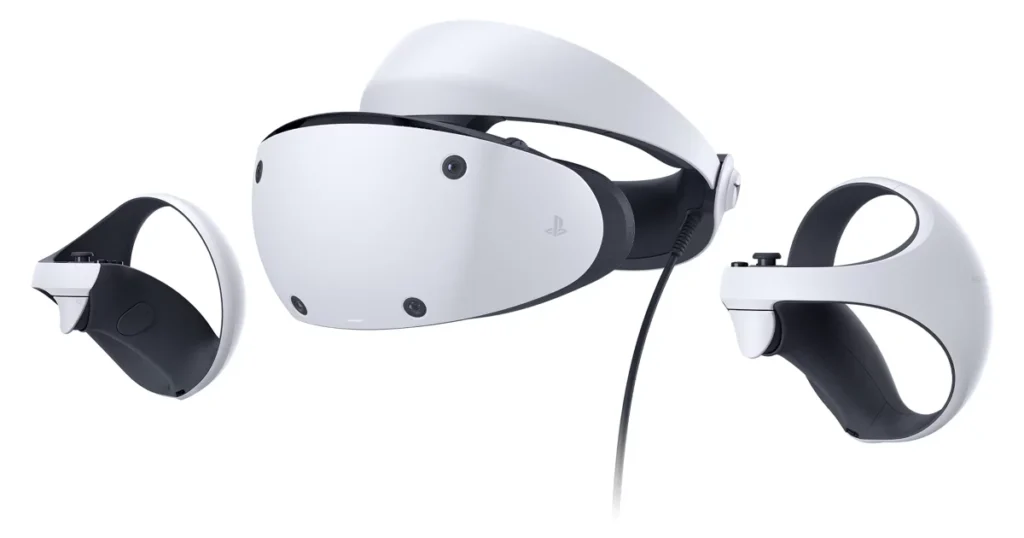
PlayStation VR2 (PSVR2): Sony’s second-generation virtual reality headset, designed exclusively for the PS5. It features significantly improved visual fidelity, inside-out tracking (no external camera required), eye tracking, headset feedback (vibration), and new Sense controllers with haptic feedback and adaptive triggers.

PULSE 3D, PULSE Elite, and PULSE Explore Wireless Headsets: These audio peripherals are designed to take full advantage of the PS5’s Tempest 3D AudioTech, providing immersive spatial sound.
PlayStation Portal: A dedicated remote play device that allows users to stream their PS5 games over Wi-Fi to a handheld screen. It features an 8-inch LCD screen and controls similar to the DualSense.
The DualSense controller, in particular, stands as more than just an iterative update; it represents a significant leap in controller technology. Its advanced haptic feedback system offers a far greater range and precision of tactile sensations compared to traditional rumble motors, capable of conveying subtle environmental details like the patter of rain or the texture of different surfaces. The adaptive triggers provide dynamic resistance, adding a new layer of physical interaction with in-game objects and actions. These features, when effectively implemented by game developers, have the potential to substantially enhance player engagement and immersion, setting a new benchmark for controller capabilities and potentially influencing future controller designs across the broader gaming industry.
Software Ecosystem: Next-Generation Experiences, Backward Compatibility, and User Interface Evolution:
The PlayStation 5’s software ecosystem is built upon delivering next-generation gaming experiences, extensive backward compatibility with the PS4 library, and a completely redesigned user interface.
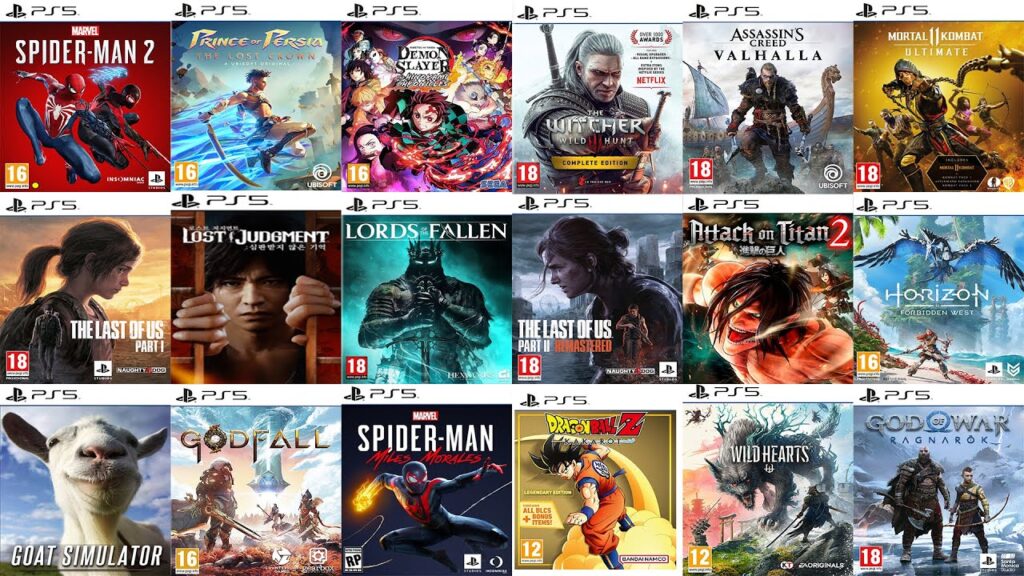
Next-Generation Exclusives: Notable PS5 exclusive titles that showcase the console’s capabilities include Marvel’s Spider-Man 2 (which sold 11 million copies) , Ratchet & Clank: Rift Apart (3.97M) , the remake of Demon’s Souls (1.857M) , Returnal, and Horizon Forbidden West. Each PS5 console comes pre-installed with Astro’s Playroom, a game designed to demonstrate the features of the DualSense controller.
Backward Compatibility: The PS5 is backward compatible with over 99% of the PlayStation 4’s extensive library of over 4,000 games. Many of these PS4 titles benefit from the PS5’s “Game Boost” feature, which can result in improved loading times, more stable frame rates, or higher resolutions. The console also supports the original PlayStation VR headset and its compatible PS4 games (via an adapter).
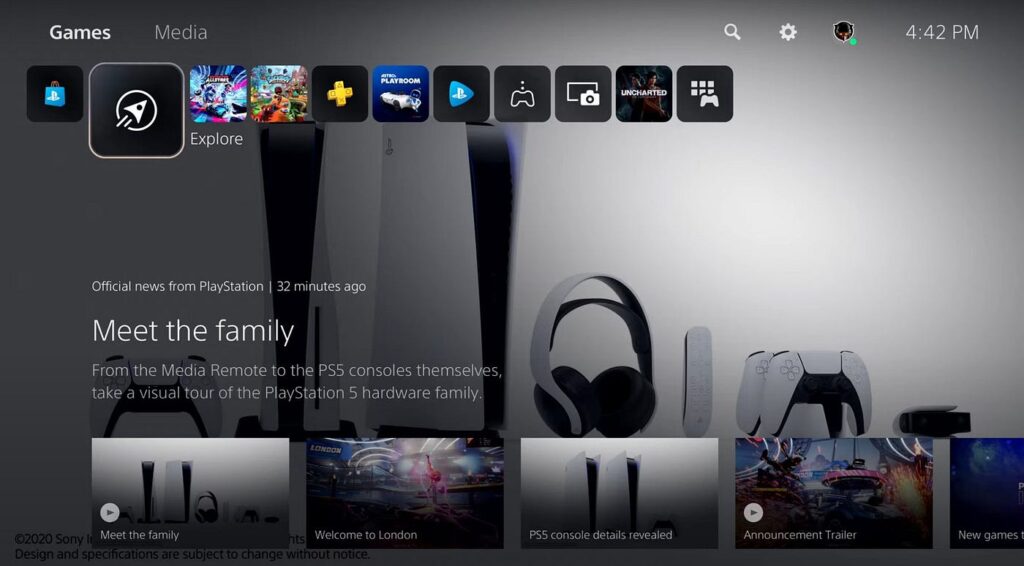
User Interface (UI): The PS5 features a completely revamped user interface, a departure from the PS4’s Dynamic Menu and the PS3’s XrossMediaBar. Key features include the “Control Center,” accessible by pressing the PlayStation button, which provides quick access to system functions, notifications, and sound/mic settings without leaving the game. A significant addition is “Cards,” which are integrated into the Control Center and game hubs. “Activity Cards” allow players to jump directly into specific game modes, levels, or challenges, track trophy progress, and view estimated completion times for certain objectives. Some Activity Cards also offer official game help (tips, videos) for PlayStation Plus subscribers. The UI also supports voice-to-text input via the DualSense controller’s built-in microphone for messaging. The home screen is cleaner, with game-specific hubs providing access to news, media, and activities related to that title.
The PS5’s user interface and user experience (UI/UX) design places a strong emphasis on speed, deep integration with game content through features like Activity Cards, and enhanced social connectivity. This reflects a sophisticated understanding of contemporary player engagement patterns. Building on the social sharing foundations laid by the PS4’s “Share” button, the PS5 UI aims to further reduce friction between playing, discovering, and sharing game experiences. The direct links to specific game activities aim to keep players engaged and minimize time spent navigating menus, aligning with the modern gamer’s desire for immediate access and curated content.
Market Performance, Sales Figures, and Critical Reception:
Despite significant supply constraints during its initial launch period, the PlayStation 5 has demonstrated robust sales momentum. As of February 2025, over 75 million units had been shipped worldwide , with 50 million units sold through to consumers by December 2023. For the fiscal year 2024 (FY24), Sony reported PS5 sales of 18.5 million units. In terms of market share through the first 52 launch-aligned months, the PS5 held 38.2% globally, 35.3% in the US, a leading 45.9% in Europe, and 24.0% in Japan.
The critical reception for the PS5 hardware has been generally positive. Reviewers have consistently praised its ultra-fast SSD, the innovative DualSense controller with its haptic feedback and adaptive triggers, and its overall performance capabilities, including support for 4K graphics at high frame rates and ray tracing. Criticisms have often centered on the console’s large physical size (though addressed by the Slim model), the initial usable storage capacity of the SSD (667GB from an 825GB drive), and some aspects of the user interface that were seen as needing refinement or lacking features from the PS4 at launch. The Metacritic user score for the PS5 hardware is currently 6.5 out of 10, categorized as “Mixed or Average,” based on 42 user ratings. It’s important to note that critic reviews for the hardware itself are not aggregated by Metacritic in the same way as games.
The PS5’s strong sales performance, achieved despite unprecedented launch supply challenges, underscores the continued high demand for dedicated, high-end console gaming experiences. The console’s technological advancements, particularly the SSD and DualSense controller, have resonated with consumers. A growing library of exclusive titles, such as Marvel’s Spider-Man 2 , continues to drive hardware adoption. This sustained demand, even years after its release, indicates a healthy appetite in the market for premium console gaming, even with the concurrent growth of mobile and cloud-based gaming platforms.
Hardware Revisions (Slim, Pro):
Following patterns established with previous PlayStation generations, Sony has introduced hardware revisions for the PS5:

PS5 Slim models (Disc and Digital Editions): Launched in November 2023, these models feature a significantly slimmer and lighter design compared to the original launch consoles. A key change is the increase in SSD storage to 1TB. The Slim Disc Edition includes an Ultra HD Blu-ray drive, while the Slim Digital Edition offers the option to add a detachable Ultra HD Blu-ray drive later, providing more flexibility for consumers.
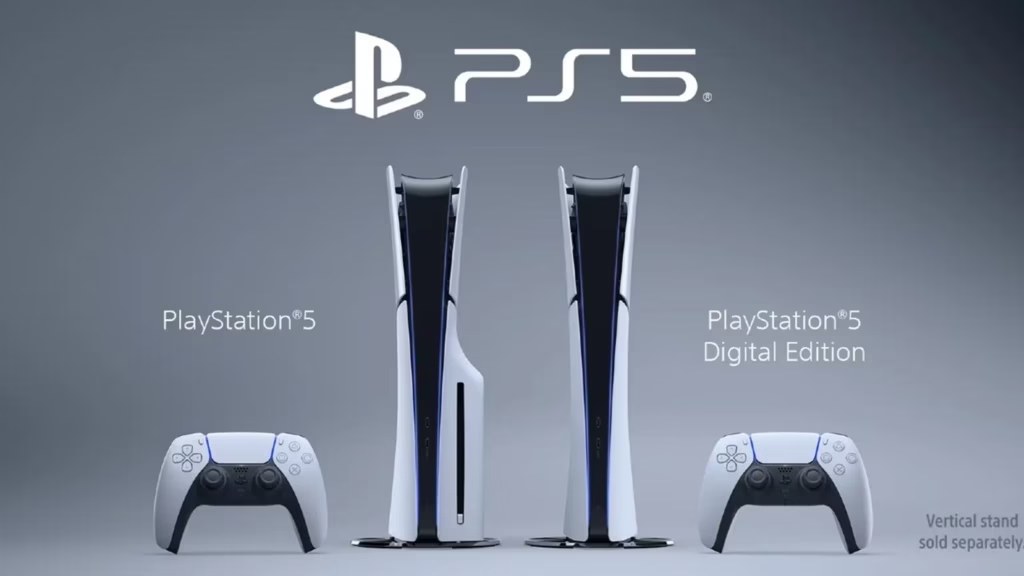
PS5 Pro: Released on November 7, 2024, the PS5 Pro is a higher-end iteration designed for enhanced performance. It boasts a faster GPU, improved ray tracing capabilities, and introduces Sony’s proprietary AI-driven upscaling technology called PlayStation Spectral Super Resolution (PSSR), aimed at delivering higher resolutions and frame rates. The PS5 Pro launched at a premium price point of US$699.
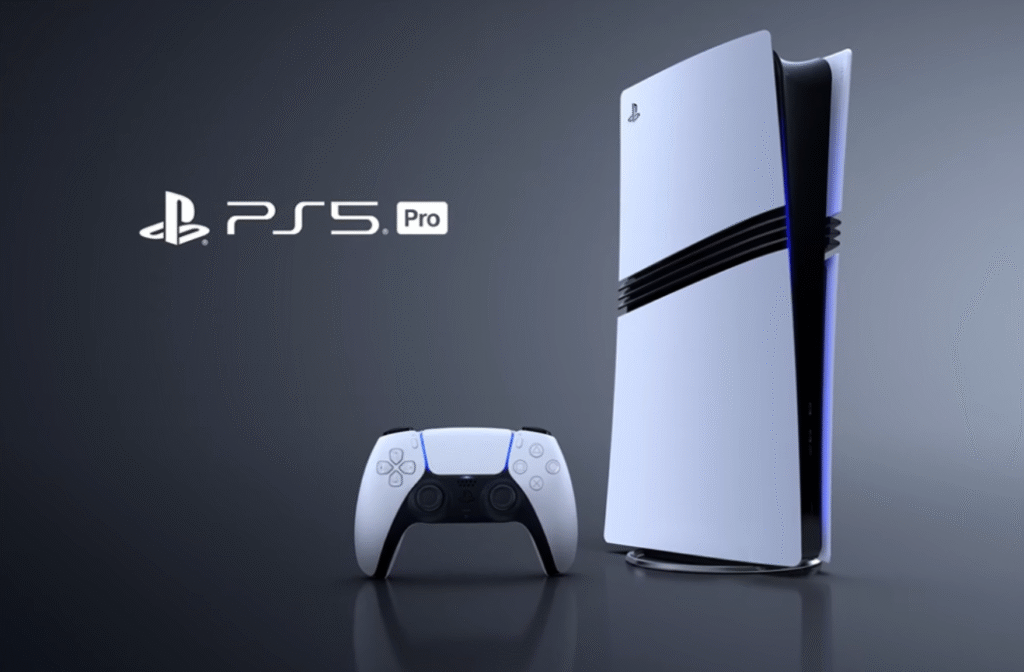
The introduction of Slim and Pro models mid-cycle is a strategic approach that Sony has refined over several console generations. The Slim models aim to broaden the market appeal by offering a more compact and potentially more affordable entry point, attracting new buyers or those who prefer a sleeker aesthetic. The Pro model, with its significantly enhanced GPU and advanced upscaling technology, targets gaming enthusiasts and early adopters of cutting-edge display technologies (like 8K TVs or high-refresh-rate 4K displays) who are willing to pay a premium for the best possible visual fidelity and performance. This tiered hardware strategy allows Sony to address different segments of the consumer market simultaneously, maintain technological relevance as the generation progresses, and extend the overall lifecycle and commercial viability of the PlayStation 5 platform.
Table: PlayStation Home Consoles – Comparative Overview
| Feature | PlayStation (PS1) | PlayStation 2 (PS2) | PlayStation 3 (PS3) | PlayStation 4 (PS4) | PlayStation 5 (PS5) |
|---|---|---|---|---|---|
| Launch Year | JP: 1994, NA/EU: 1995 | JP/NA/EU: 2000 | JP/NA: 2006, EU: 2007 | NA/EU: 2013, JP: 2014 | Worldwide: 2020 |
| CPU | 32-bit MIPS R3051 @ 33.8MHz | 128-bit “Emotion Engine” @ ~300MHz | Cell Broadband Engine @ 3.2GHz | 8-core AMD Jaguar x86-64 | 8-core AMD Zen 2 @ up to 3.5GHz |
| GPU | Sony GPU | “Graphics Synthesizer” @ 147MHz | Nvidia RSX “Reality Synthesizer” @ 500MHz | AMD Radeon (GCN) 1.84 TFLOPS | AMD Radeon (RDNA 2) 10.28 TFLOPS |
| RAM | 2MB Main, 1MB Video | 32MB RDRAM, 4MB eDRAM | 256MB XDR Main, 256MB GDDR3 Video | 8GB GDDR5 Unified | 16GB GDDR6 Unified |
| Storage Medium | CD-ROM | DVD-ROM, CD-ROM | Blu-ray Disc, DVD, CD | Blu-ray Disc, DVD | Ultra HD Blu-ray, Blu-ray, DVD |
| Key Innovations | CD-ROM, 3D Graphics, DualShock | Emotion Engine, DVD Playback, Backward Compatibility | Cell Processor, Blu-ray, PSN, HDMI | x86 Architecture, Share Button, Social Features, Remote Play | Custom NVMe SSD, DualSense Controller, Ray Tracing, 3D Audio |
| Launch Price (NA) | US$299 | US$299 | US$499 (20GB) / US$599 (60GB) | US$399 | US$399 (Digital) / US$499 (Disc) |
| Units Sold (WW) | 102.49 million | >160 million | ~87.4 million | >117.2 million | >75 million (shipped, as of Feb 2025) |
This table provides a concise, at-a-glance comparison of the core technical evolution and market success of each home console generation. It allows readers to quickly identify trends in processing power, memory, storage solutions, and the impact of key innovations on sales and market positioning. This directly supports the article’s goal of providing a comprehensive, encyclopedic overview.
Expanding the Ecosystem: Handhelds and Other Hardware Ventures
PlayStation Portable (PSP) (2004-2014): Gaming on the Go

Concept, Market Entry, and Multimedia Ambitions:
The PlayStation Portable (PSP) was officially announced by Sony at E3 in 2003 and fully unveiled at E3 2004. Sony positioned the device ambitiously, with Ken Kutaragi famously calling it the “Walkman of the 21st century,” underscoring its intended role as a comprehensive multimedia device capable of playing games, music, and movies. The PSP made its debut in Japan on December 12, 2004, with an initial price of ¥19,800 for the base model. It subsequently launched in North America on March 24, 2005, priced at US$249.99, and in PAL regions on September 1, 2005. With the PSP, Sony aimed to challenge Nintendo’s long-standing dominance in the handheld gaming market, a space where many previous competitors had failed to make a significant impact.
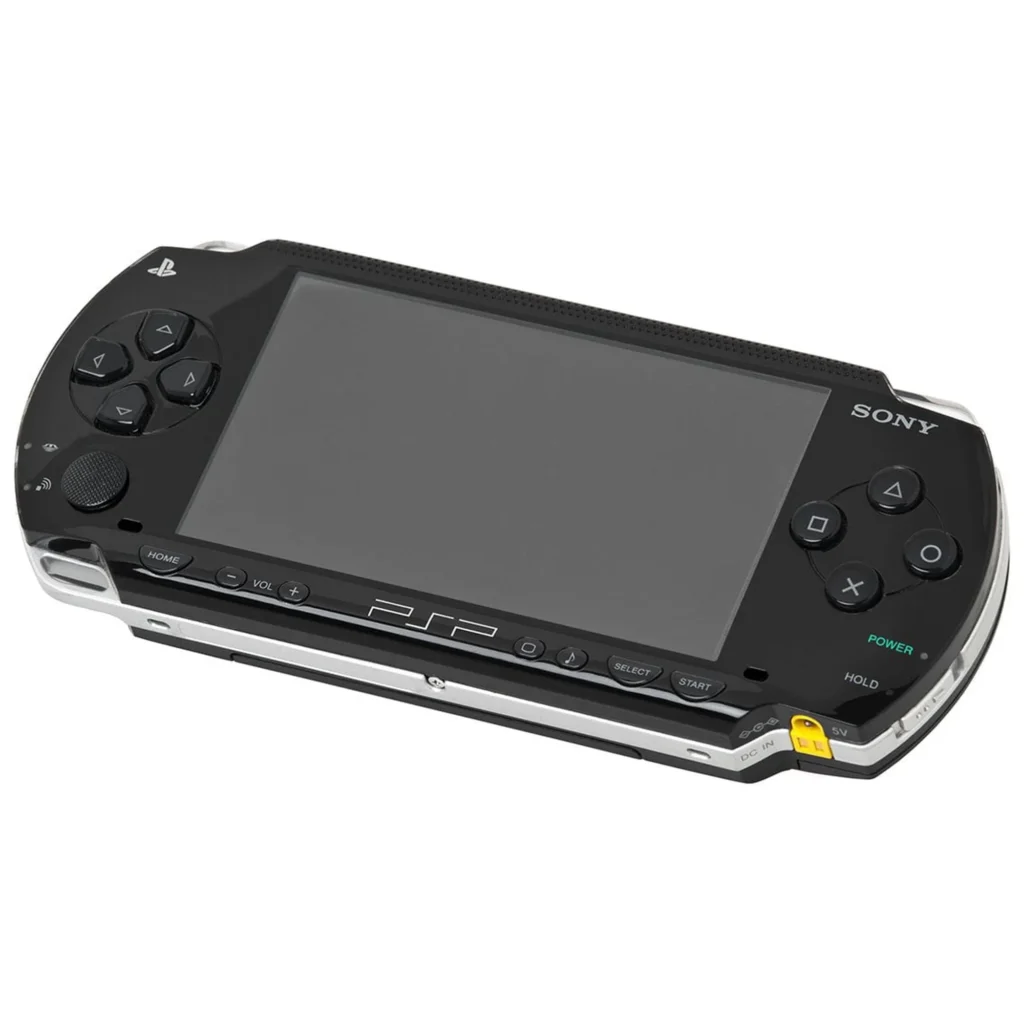
The PSP’s market entry strategy represented Sony’s bold attempt to replicate its home console success in the portable arena. Rather than directly mirroring Nintendo’s typically game-centric and often more budget-conscious handhelds, Sony leveraged its extensive experience in consumer electronics to create a premium, feature-rich portable device. The inclusion of the Universal Media Disc (UMD) format for movies , alongside MP3 playback capabilities , was intended to attract an older demographic and position the PSP as an all-in-one entertainment gadget. This approach mirrored the way the PlayStation 2’s DVD playback functionality had broadened its appeal beyond hardcore gamers, aiming for a similar expansion of the handheld market.
Technical Specifications and Key Features:
The PlayStation Portable boasted hardware specifications that were remarkably advanced for a handheld device at the time of its release.
CPU: It was powered by two MIPS R4000-based CPUs, one serving as the main processor and the other as a dedicated Media Engine, both capable of running at up to 333 MHz. Initially, for software, the CPU speed was capped at 222 MHz to conserve battery life, but firmware update 3.50 in May 2007 unlocked the full 333 MHz for newer games.
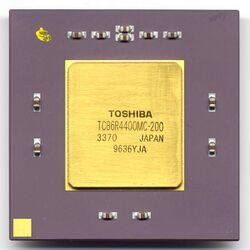
Memory: The original PSP-1000 model included 32 MB of main RAM and 4 MB of embedded DRAM (eDRAM). Later models, starting with the PSP-2000 (“Slim & Lite”), doubled the main RAM to 64 MB.
Display: A standout feature was its 4.3-inch 16:9 widescreen TFT LCD, capable of displaying 16.77 million colors at a resolution of 480×272 pixels. This offered a significantly more vibrant and detailed visual experience compared to its main competitor, the Nintendo DS.
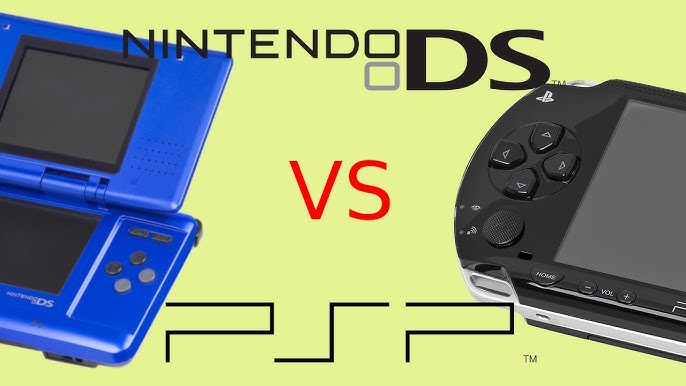
Media: The PSP utilized the proprietary Universal Media Disc (UMD) format for both games and movies. Each UMD could store up to 1.8GB of data.
Connectivity: It featured integrated Wi-Fi (IEEE 802.11b) for online gaming and internet browsing, a USB 2.0 (mini-B) port for PC connectivity and charging, and a Memory Stick PRO Duo slot for expandable storage. Early models (PSP-1000) also included an IrDA (infrared) port, which was later removed.
Key features that defined the PSP experience included its advanced graphics capabilities for a handheld, robust multimedia playback for music (MP3, ATRAC3plus) and video (MPEG-4), a built-in web browser, and support for online multiplayer gaming via the PlayStation Network.
The PSP’s hardware was undeniably powerful for its era, enabling near-PlayStation 2 quality graphics and facilitating more complex game designs than previously seen on portable systems. This power, however, came with certain trade-offs. The advanced processing and vibrant screen contributed to higher battery consumption compared to less powerful handhelds. Furthermore, the mechanical nature of the UMD drive, while offering substantial storage capacity, led to longer game loading times compared to the solid-state cartridges used by Nintendo’s handhelds and also contributed to battery drain. These were inherent compromises made to achieve its ambitious multimedia and high-fidelity gaming goals.
Game Library, Market Performance, and Critical Reception:
The PlayStation Portable ultimately sold between 80 and 82 million units worldwide over its ten-year lifespan, with Sony officially shipping 82.52 million units. This made it a significant commercial success, though it was outsold by its primary competitor, the Nintendo DS, which achieved sales of approximately 154 million units.
The PSP’s game library featured a number of best-selling and critically acclaimed titles. The top-selling game was Grand Theft Auto: Liberty City Stories, with 8 million units sold. Other major commercial successes included Monster Hunter Portable 3rd (4.9 million units), Gran Turismo (4.67 million units), Grand Theft Auto: Vice City Stories (4.5 million units), and Monster Hunter Freedom Unite (3.8 million units).
At its launch, the PSP was generally received positively by critics, who lauded its powerful hardware, impressive widescreen display, and ambitious multimedia capabilities. Edge magazine, for example, described it as an “instant design classic.” However, some contemporary reviews and user feedback pointed out concerns such as noticeable blurring on the LCD screen during fast motion, the glossy finish being a fingerprint magnet, the vulnerability of the UMD discs (lacking a protective shutter like MiniDiscs), and relatively shorter battery life compared to less powerful handhelds. The Metacritic user score for the PSP hardware stands at 7.9 out of 10, indicating “Generally Favorable” reception from users.
While the PSP was a considerable commercial success in its own right, and stands as the only handheld console to have significantly competed with Nintendo for market share during its active years , it ultimately could not dethrone the Nintendo DS. The DS, with its lower price point, innovative dual-screen and touch-input gameplay, broader demographic appeal, and a very strong lineup of Nintendo’s first-party franchises, captured a larger segment of the handheld market. The PSP’s experience highlights the complexities of competing against an entrenched market leader, demonstrating that superior raw hardware power and multimedia features do not always guarantee market leadership, especially when faced with unique gameplay innovations and strong brand loyalty. Sony also cited video game piracy as a factor that negatively impacted PSP sales more than anticipated.
Hardware Revisions:
Throughout its lifespan, Sony released several hardware revisions of the PSP to refine its design, reduce costs, and add features:
PSP-2000 (“Slim & Lite”) (2007): This model was thinner and lighter than the original PSP-1000, featured an improved LCD screen, doubled the main RAM to 64MB, and added a video-out port.
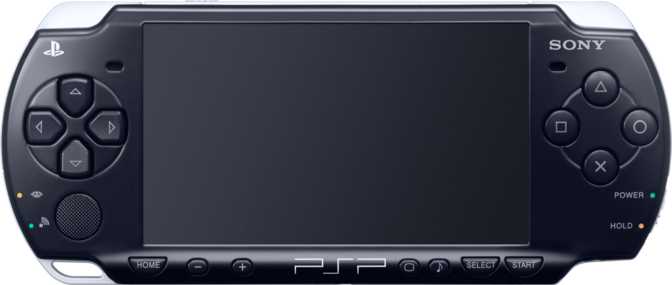
PSP-3000 (2008): Further improved the LCD screen with a wider color gamut and better anti-reflective technology, and included a built-in microphone.

PSP Go (PSP-N1000) (2009): A radical redesign that was smaller and lighter, featuring a sliding screen mechanism. It notably removed the UMD drive entirely, relying solely on digital downloads from the PlayStation Store and 16GB of internal flash memory. This model was not as commercially successful as previous iterations. [ (UMD except PSP Go)]
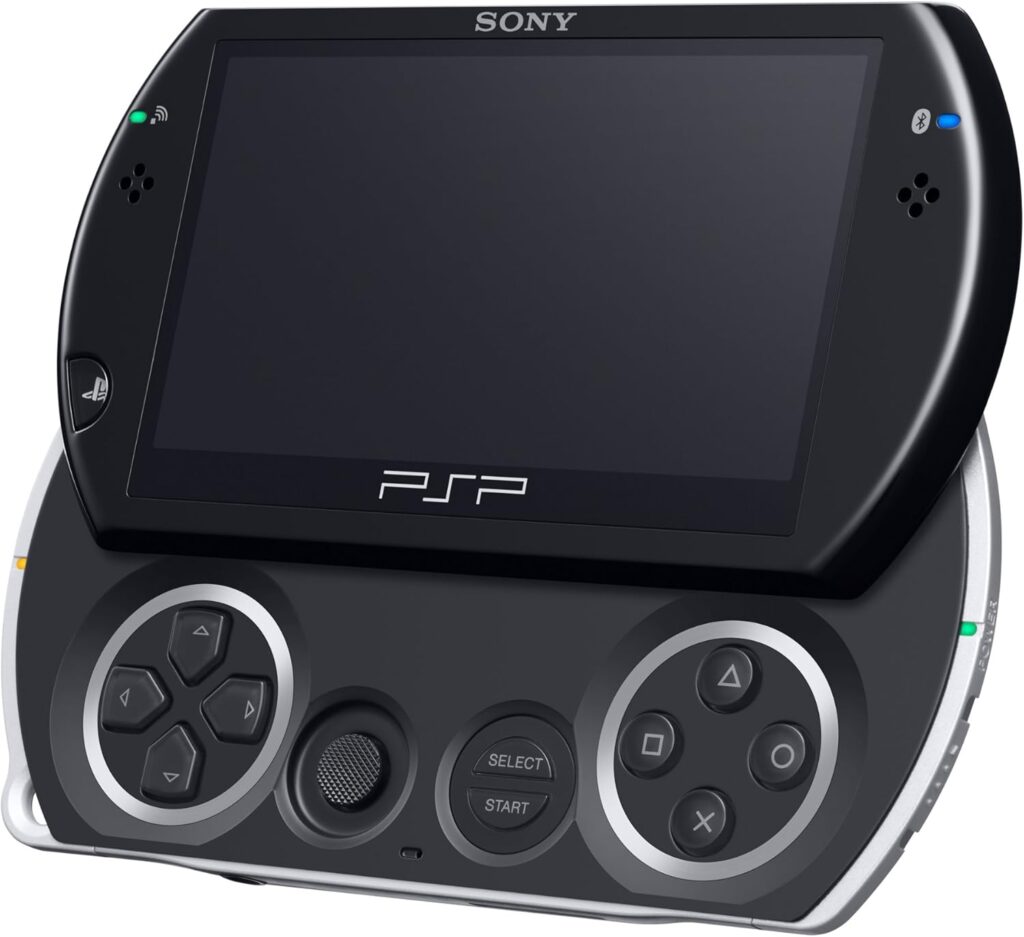
PSP-E1000 (2011, PAL regions only): A budget-focused model that removed Wi-Fi capabilities and featured a matte finish, aimed at a lower price point.
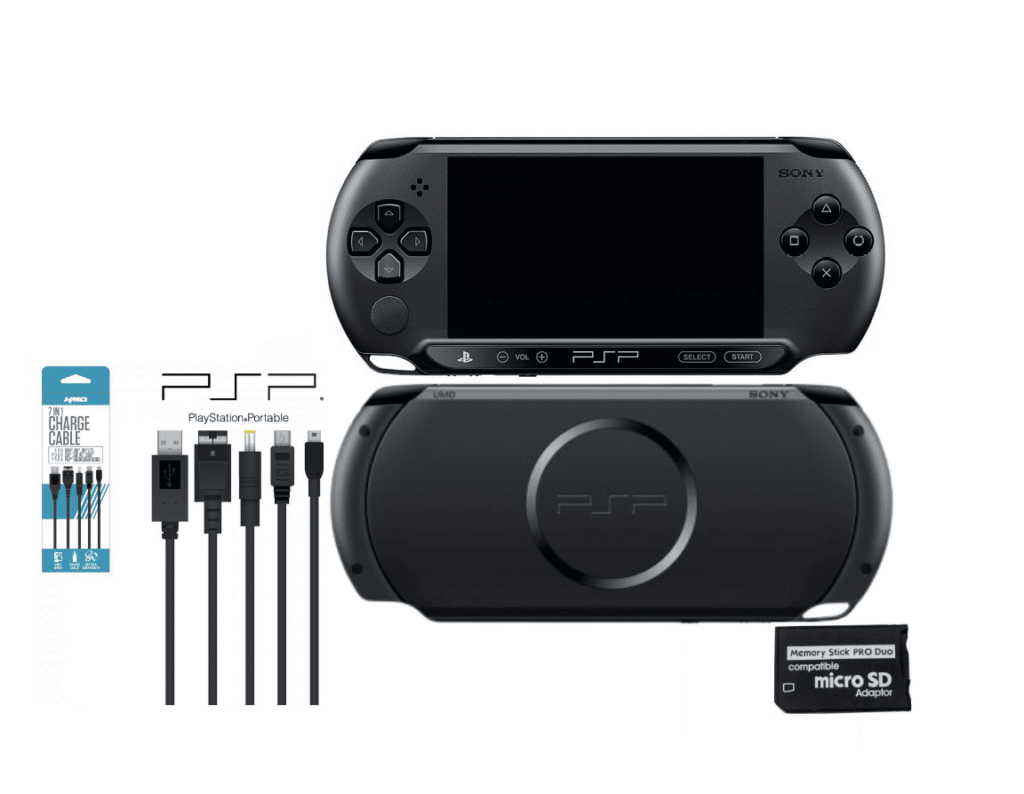
B. PlayStation Vita (PS Vita) (2011-2019): Powerful Portability
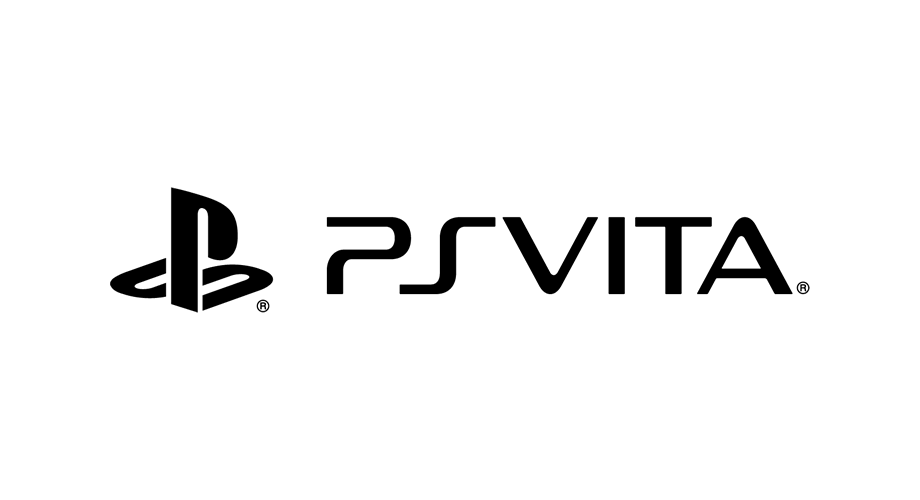
Innovations and Design:
The PlayStation Vita was Sony’s successor to the PSP, launched in Japan on December 17, 2011, with an introductory price of ¥24,980 for the Wi-Fi model (approximately US$249.99 at the time). Its international release followed on February 22, 2012. The Vita was designed to bridge the gap between dedicated console gaming and the burgeoning mobile gaming market, offering a high-fidelity portable experience.
Key design innovations included a vibrant 5-inch OLED multi-touch capacitive touchscreen (on the original PCH-1000 model; later revised to an LCD screen in the PCH-2000 model), a unique rear touchpad that allowed for additional input methods, and, crucially, dual analog joysticks, which provided a more console-like control scheme suitable for complex 3D games. The Vita also featured front and rear cameras and integrated Sixaxis motion sensing (a three-axis gyroscope and a three-axis accelerometer).

The Vita was a technologically ambitious handheld, packed with features intended to deliver a premium, console-like experience on the go. The inclusion of dual analog sticks was a direct response to a key limitation of the original PSP, aiming to provide developers and players with the control fidelity needed for genres like first-person shooters and complex action-adventure games. The high-resolution OLED screen offered superior visual quality with deep blacks and vibrant colors. However, Sony’s strategic decision to use expensive proprietary memory cards, rather than standard formats like SD cards, became a significant point of contention and a barrier to entry for many potential consumers. Furthermore, the Vita launched into a rapidly evolving market where smartphone gaming was becoming increasingly sophisticated and accessible, offering often cheaper or free-to-play alternatives, which significantly impacted the dedicated handheld gaming landscape.
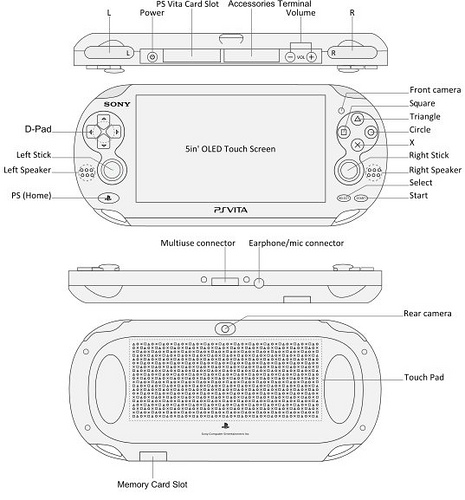
Technical Specifications and Connectivity:
The PlayStation Vita was equipped with powerful hardware for a portable device of its time.
CPU: It featured a quad-core ARM Cortex-A9 MPCore processor, capable of clock speeds up to 2 GHz, though it typically operated at lower speeds to conserve battery life.
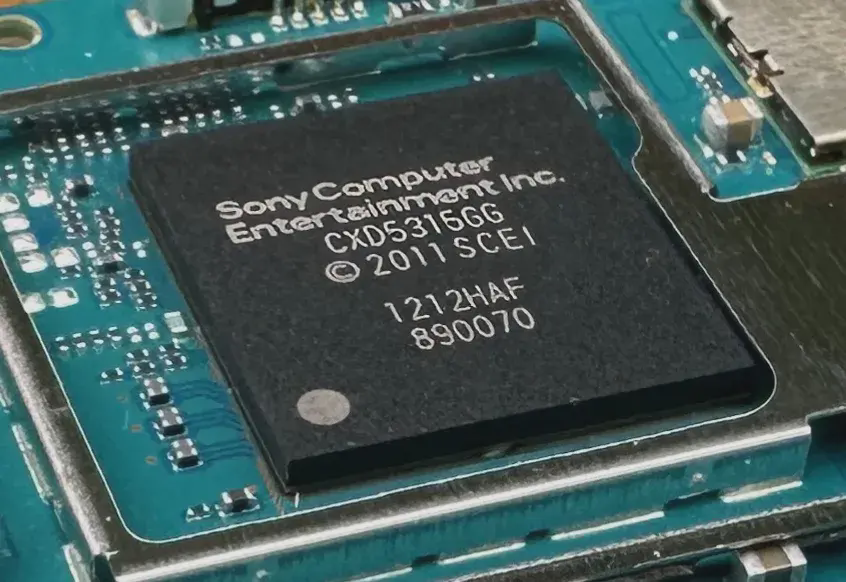
GPU: Graphics were handled by a quad-core PowerVR SGX543MP4+ GPU.
Memory: The system included 512 MB of main RAM and 128 MB of VRAM.
Storage: Game data and saves were stored on proprietary PlayStation Vita memory cards, available in various capacities ranging from 4GB to 64GB. The revised PCH-2000 model also included 1 GB of internal flash memory.
Media: Games were distributed on “PlayStation Vita game cards,” which were small, flash memory-based cartridges, moving away from the PSP’s UMD optical disc format.
Connectivity: Standard connectivity included Wi-Fi (IEEE 802.11b/g/n) and Bluetooth 2.1+EDR. An optional launch model also featured 3G mobile broadband connectivity, though this variant was later discontinued.
The Vita’s hardware, with its multi-core CPU and GPU, was in some respects comparable in capability to the PlayStation 3 , enabling visually rich and complex gaming experiences that were a significant step up from the PSP. The transition from UMDs to flash-based game cards was a positive development, offering faster load times and greater durability. However, the mandatory use of Sony’s expensive proprietary memory cards for all digital downloads and game saves remained a persistent criticism throughout the Vita’s lifecycle, perceived by many as an anti-consumer practice that inflated the true cost of ownership.

Game Library, Market Challenges, Remote Play Functionality, and Critical Reception:
The PlayStation Vita launched with a strong initial lineup of 26 titles in Japan. Notable games throughout its lifespan included Uncharted: Golden Abyss (its best-selling title with approximately 1.42-1.46 million units sold) , the critically acclaimed JRPG Persona 4 Golden , the creatively unique Tearaway , first-person shooter Killzone: Mercenary , and the innovative Gravity Rush.
Despite these quality titles, the Vita faced significant market challenges. Estimated worldwide sales hover around 14 to 16 million units, a figure substantially lower than its predecessor, the PSP, and massively outsold by its direct competitor, the Nintendo 3DS. Several factors contributed to its commercial struggles: its relatively high launch price, the very expensive proprietary memory cards, intense competition from the rapidly growing mobile gaming sector, and the loss of key third-party franchises like Monster Hunter, which had been a system-seller for the PSP but largely moved to Nintendo platforms during the Vita’s era.
A key feature heavily promoted by Sony was Remote Play, which allowed users to stream and play their PlayStation 4 games (and a limited selection of PS3 titles) on the Vita’s screen over a Wi-Fi connection. This positioned the Vita as a companion device to the PS4.
The Vita’s critical reception at launch was generally positive, with reviewers praising its powerful hardware, beautiful OLED screen, the inclusion of dual analog sticks (a significant improvement over the PSP), and the console-quality of some launch titles. However, criticisms were often directed at the sometimes cumbersome implementation of its touch features in games, the ergonomics of the rear touchpad, and its high price point. The Metacritic user score for the Vita hardware is 6.0 out of 10 (“Mixed or Average”), based on a small sample of 6 user ratings.
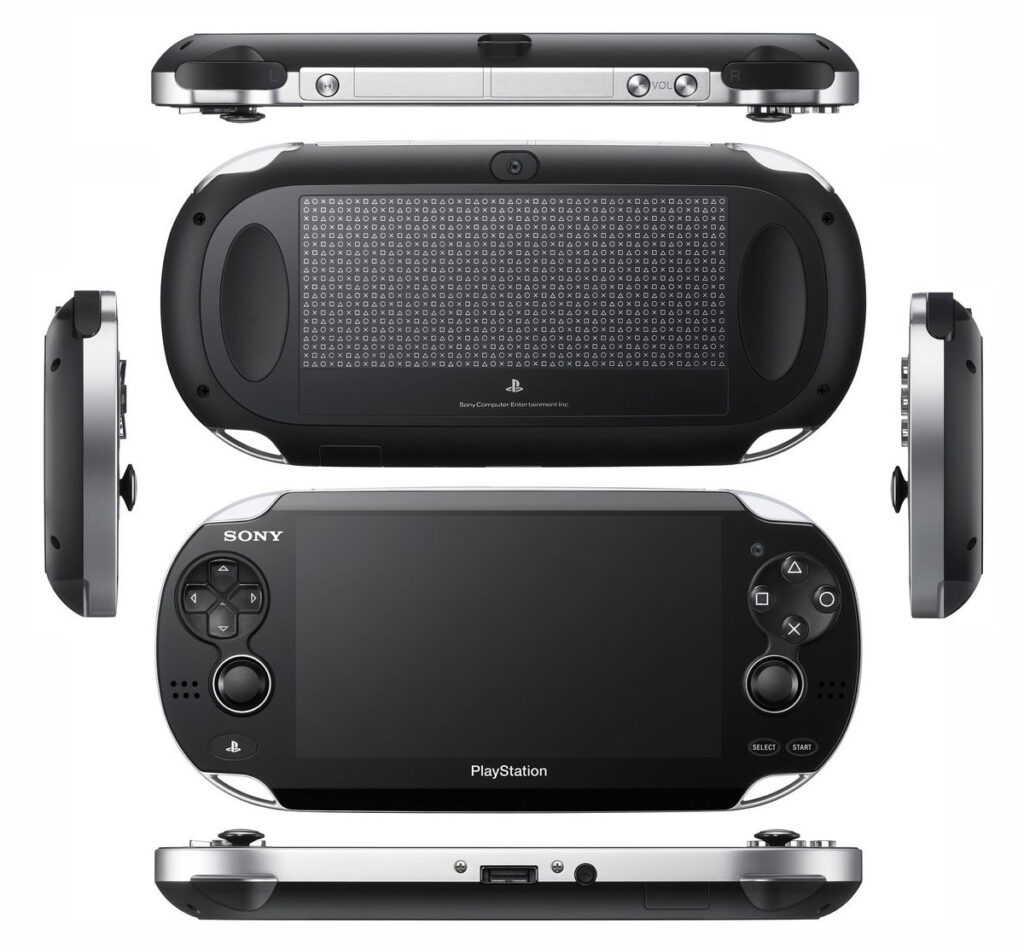
Ultimately, the PlayStation Vita is widely regarded as a commercial failure for Sony. Its technical prowess and strong early game offerings were overshadowed by a combination of Sony’s strategic missteps (particularly the proprietary memory cards and pricing), fierce competition from both the Nintendo 3DS and the burgeoning smartphone gaming market, and a perceived decline in sustained first-party software support and compelling “killer applications” as its lifecycle progressed. Sony’s eventual shift in focus towards marketing the Vita primarily as a PS4 accessory via Remote Play, rather than as a standalone handheld platform with a continuous stream of dedicated first-party titles, further signaled its diminishing prospects as a primary gaming device.
Hardware Revisions:
Sony released a revised model, the PCH-2000 series (often called Vita Slim), in 2013. This version was thinner and lighter than the original, replaced the OLED screen with an LCD panel (which some users found to be a downgrade in visual quality, though it helped reduce cost and potentially improve battery life), included 1 GB of internal storage (primarily for system data, still requiring a memory card for most game installs and downloads), and offered slightly improved battery life.
Specialized and Niche Hardware:
PocketStation (1999, Japan-Exclusive Memory Card Peripheral):
The PocketStation was a unique peripheral released by Sony Computer Entertainment exclusively in Japan on January 23, 1999. It functioned as a standard PlayStation memory card but also incorporated features of a miniature personal digital assistant (PDA) and a simple handheld gaming device. It featured a monochrome LCD screen, infrared communication capabilities, a real-time clock, built-in flash memory for game saves, and sound output via a miniature speaker. The device was powered by an ARM7T 32-bit RISC CPU and had 2KB of SRAM alongside 128KB of Flash RAM (accessed via the PlayStation’s memory card slot).
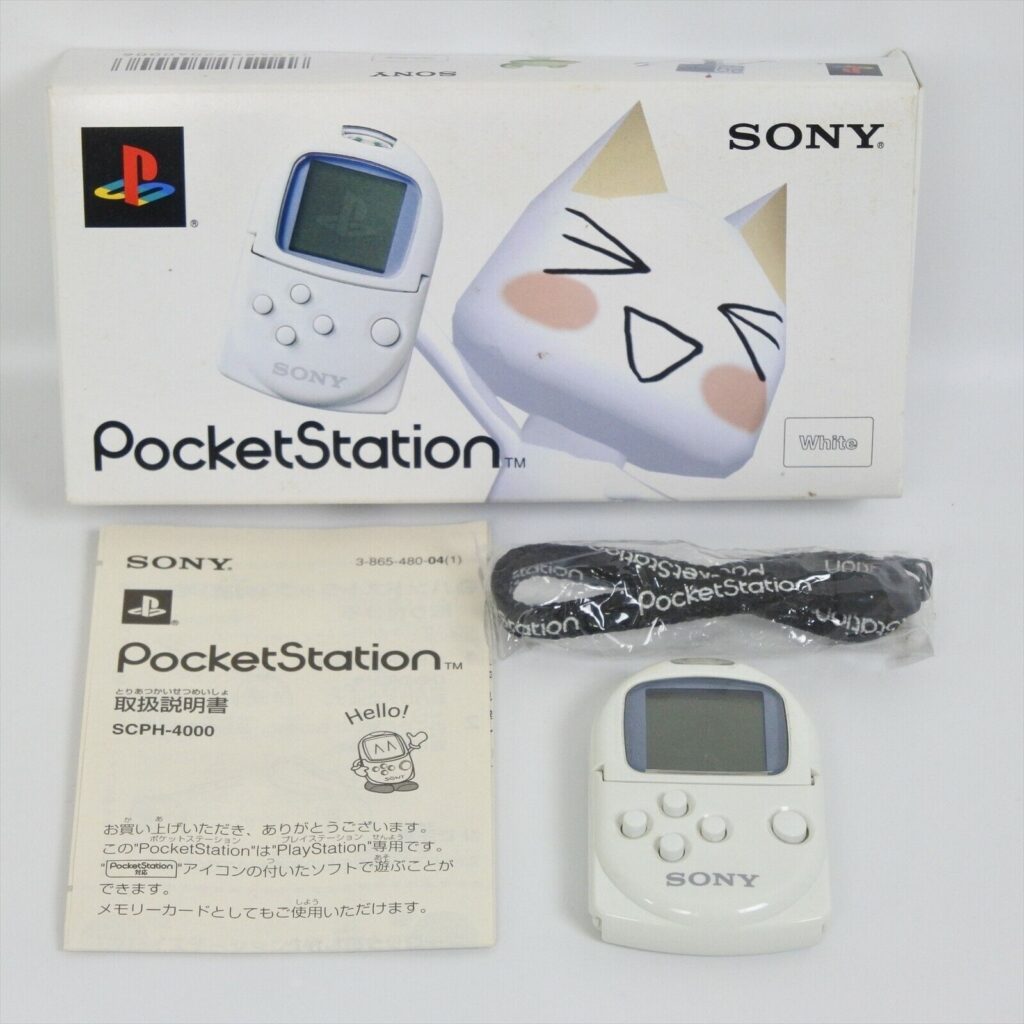
Software for the PocketStation was typically distributed as bonus content on PlayStation game CD-ROMs, offering mini-games or enhanced features that could be downloaded to the device. Its infrared port allowed for direct data transfer between PocketStation units, facilitating simple multiplayer gaming and data exchange. The most popular game for the peripheral was Doko Demo Issyo, which sold over 1.5 million copies in Japan and introduced Sony’s future mascot, Toro Inoue.
The PocketStation proved to be extremely popular in Japan, selling out rapidly upon release. Sony had initially shipped only 60,000 units. Due to this high domestic demand, planned releases in Europe and North America were ultimately canceled, although some Western PlayStation games retained their PocketStation functionality. Production of the PocketStation ceased in July 2002, after nearly five million units had been shipped. In a nod to its cult status, Sony revived the PocketStation as a downloadable application for the PlayStation Vita in Japan in 2013, allowing users to play its compatible mini-games.
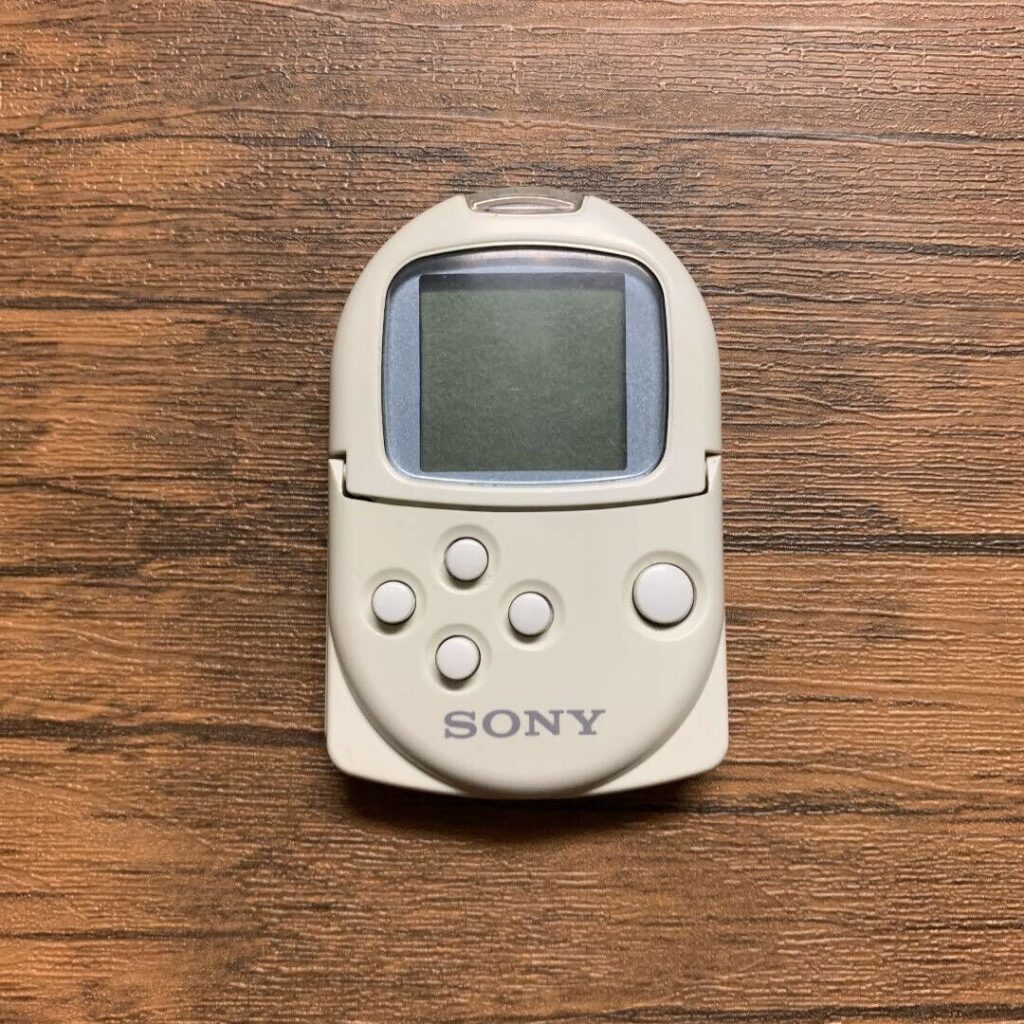
The success of the PocketStation in its limited market demonstrated an early consumer appetite for interactive peripherals and bite-sized gaming experiences that could extend or complement main console gameplay. It can be seen as a precursor to concepts like second-screen gaming or companion applications that became more prevalent in later console generations. Its infrared data transfer also hinted at early forms of local wireless connectivity for gaming devices.
PSX (DVR Hybrid – 2003, Japan-Exclusive)
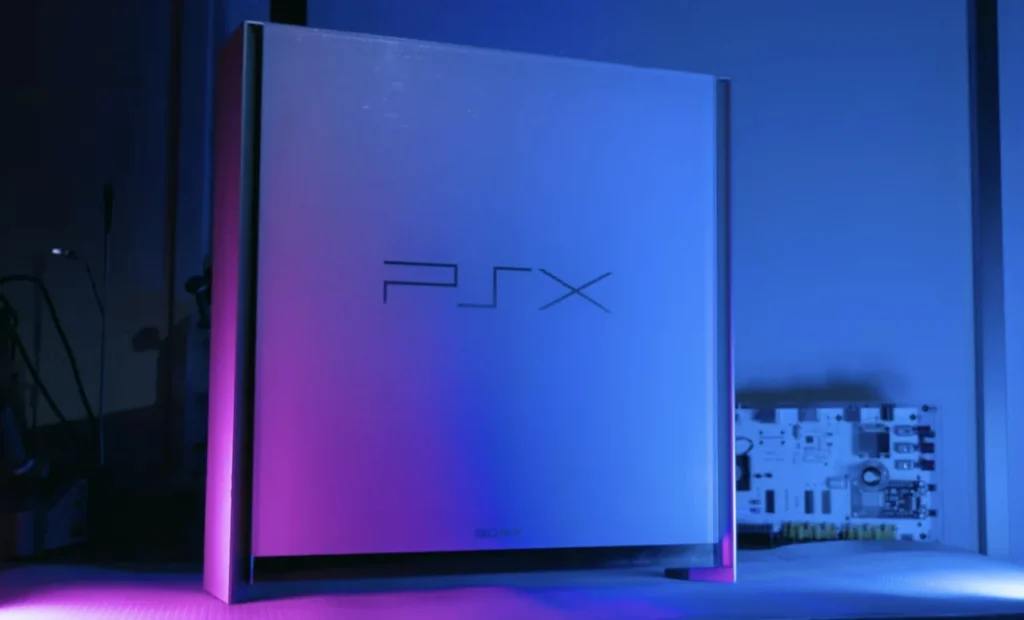
The PSX was a high-end multimedia device launched by Sony in Japan on December 13, 2003. It was an ambitious attempt to integrate a fully functional PlayStation 2 console with a Digital Video Recorder (DVR). The PSX featured an analog television tuner, the ability to record TV broadcasts and DVDs, broadband internet connectivity, a Memory Stick slot for media playback (MP3s, photos), and was the first Sony device to feature the XrossMediaBar (XMB) graphical user interface, which would later become standard on the PSP and PS3. Internally, it was powered by a single chipset that combined the PS2’s Emotion Engine CPU and Graphics Synthesizer GPU (the 90nm EE+GS). Several models were released, differing primarily in hard drive capacity (e.g., DESR-5000 with 160GB HDD, DESR-7000 with 250GB HDD).
Despite its advanced features, the PSX was very expensive, with launch prices around ¥79,800 – ¥99,800 (approx. $749 – $849 USD at the time). It was never officially released outside of Japan. Criticisms included the fact that the game controller was sold separately despite the high price, and inconvenient port placement. Approximately 250,000 units were reportedly sold
Playstation Website